| |
Glossary of Coral Reef Terminology - C
c-card - a scuba diving certification card from scuba certifying agencies, such as NAUI, BSAC, NOAA, PADI, etc. |
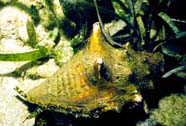
This Queen Conch (Strombus gigas) utilizes calcium carbonate in forming its protective shell. (Photo: Andy Bruckner)
|
CaCO3 (calcium carbonate) - a molecule consisting of calcium, carbon and oxygen secreted by corals to their skeleton. It is also secreted by mollusks to form their protective shells |
cacophonous - having a harsh, unpleasant sound |
cacospongionolide B - an antiinflammatory drug derived from the marine sponge Fasciospongia cavernosa |
cadastral survey - a survey which creates, marks, defines, retraces or reestablishes the boundaries and subdivisions of the public land of the United States. It is derived from the word cadastre, meaning a public record, survey, or map of the value, extent, and ownership of land as a basis of taxation |
caecum - a blindly ending sac arising from the gut or some other hollow organ |

The Calcarea is a class of small, delicate, marine sponges whose spicules are made up of calcium carbonate. Most are tubular or vase-shaped, and they can have asconoid, syconoid, or leuconoid organizations. (Photo: P. Madl and M.Yip)
|
Calcarea - a class of exclusively marine calcareous sponges (phylum Porifera) that possesses spicules composed of calcium carbonate. They are predominantly found in shallow, temperate and tropical waters, though at least one species is known from a depth of 4,000 meters. Some inhabit coral reefs. The Calcarea is thought to be most primitive group of sponges. It is the only class with asconoid and syconoid grades of construction, though some species are leuconoid. Generally,they are small in size. The different shapes are relatively simple, either purse, vase, pear or cylindrical |
calcareous - composed of or containing a substance made of calcium carbonate |
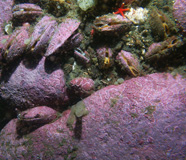
Cobbles with magenta calcareous algae, starfish, and mussels. (Photo: USGS)
|
calcareous algae - algae which deposit calcium carbonate in its tissues. When they die and decompose, their calcium carbonate skeletons are left behind to form or contribute to the growth of a reef. Calcareous algae also provide an adhesive function, cementing reef components together; see "coralline algae" |
calcareous ooze - a biogenous sediment that is made of the calcium carbonate shells and skeletons of marine organisms |
calceolus - complex sensory organelles on the antennules of some decapod crustaceans |
calcification - the process by which corals and calcareous algae extract calcium from seawater and produce it as calcium carbonate |
calcite - a mineral made up of a crystalline form of calcium carbonate |
calcite skeleton - a skeleton composed of the calcite form of calcium carbonate |
calculus - a stone-like structure formed within the body, particularly in the gall bladder (gallstone), bladder (bladder stone) and kidneys (kidney stone); the branch of mathematics that is concerned with limits and with the differentiation and integration of functions |
calibrate - to check or adjust the graduations of a quantitative measuring instrument |
calice - the oral surface of the corallite |
calice relief - the height of a corallite or corallite series |
calicle - one of the small cuplike cavities, often with elevated borders, covering the surface of most corals. Each is formed by a coral polyp; the calyx |
calicoblastic epithelium - a thin squamous epithelial layer of cells in stony (hard) corals which deposits the white calcium carbonate skeleton; also called "calicodermis" |
calipee - a fatty, gelatinous substance in green turtles, traditionally used in the preparation of green turtle soup |
callyspongynic acid - a bioactive compound, isolated from the marine sponge Callyspongia truncata, interferes with glycogen hydrolysis thereby keeping glucose concentrations in the blood at low levels. It can be used in the treatment of diabetes |

A volcanic cone rising from a calm sea. (Photo: Dr. Igor Smolyar, NOAA)
|
calm - the condition of the water surface when there are no winds, waves or swell |
calorie - a unit of measurement defined as 4.184 absolute joules or the amount of energy it takes to raise the temperature of one gram of water from 15 to 16 degrees Celsius (or 1/100th the amount of energy needed to raise the temperature of one gram of water at one atmosphere pressure from 0 degrees C to 100 degrees C). Food calories are actually equal to 1,000 calories (1 food calorie = 1 kilocalorie) |
calorimetry - measurement of the amounts of heat absorbed or given out; measurement of heat flow |
Calvin cycle - a series of biochemical reactions that take place in the stroma of chloroplasts during photosynthesis. It´s main result is the assimilation of carbon. Environmental carbon dioxide is reduced and incorporated into organic molecules, including sugars. It is one of the light-independent reactions (dark reactions) of photosynthesis; also called the Calvin-Benson cycle |
calyciform - goblet or cup-shaped |
calyculus - a cavity in a coral which contains polyps |
calypto - a prefix meaning "covered" |
calyptoblastic - in hydrozoans, hydroids with complete gonothecal cups around the polyps |
calyx - the upper or open end of the corallite or coral polyp cup; the central body of entoprocts (goblet worms) or crinoids (sea lilies and feather stars) |
Cambrian - a major division of the geologic timescale that extended from at least 580 million years ago to 500 million years ago. It marks the beginning of the Paleozoic Era. The name comes from the Cambrian Mountains in Wales, where the strata of the Cambrian were first defined |
Cambrian explosion - a burst of evolutionary origins when most of the major body plans of animals suddenly appeared in a relatively brief time in geological history, approximately 530 to 570 million years ago; the seemingly rapid appearance of most major groups of complex animals in the fossil record, around 530 million years ago, accompanied by a major diversification of other organisms |
camouflage - the use of color patterns, shape, texture, and/or behavior that allows an animal to blend in with its surroundings and thus remain concealed from predators or prey |
CaMPAM (Caribbean Marine Protected Area Management) - a network of managers of marine and coastal protected areas in the wider Caribbean organized to achieve goals of conservation and sustainable use of Caribbean coastal and marine environmental resources. General activities conducted through CaMPAM's membership include sharing experiences and addressing management challenges by facilitating training opportunities, information exchange, communication, and problem solving |
campaniform - bell-shaped |
campanulate - bell-shaped |
canal - a groove, tube, or duct |
canaliculus - a very small canal |
cancellous - possessing a spongy or porous surface |
cancellous - reticular, spongy, or lattice-like structure; usually pertains to bone |
cancroid - resembling a crab |

Moray eels are armed with sharp canine teeth used for capturing prey and also for defense. (Photo: Dr. Tom Doeppner, Brown University)
|
canine tooth - a pointed, conical tooth that is located at the front or edge of the jaw. Canine teeth are used for piercing and grabbing prey |
cannibalism - predation of an animal by a member of its own species |
canopy - the more or less continuous cover of branches and foliage formed collectively by the tops, or crowns, of adjacent trees |
cape - a piece of land that that projects out into a large body of water |
capillary - a minute blood vessel that connects the arteries and veins. Capillary walls are one-cell thick (endothelium) and act as semipermeable membranes for the interchange of various substances, including fluids, between the blood and tissue fluids; a tube of small internal diameter which holds liquid by capillary action |
capillary action - the means by which liquid moves through the porous spaces in a solid, such as soil, plant roots, and capillary blood vessels due to the forces of adhesion, cohesion, and surface tension. Capillary action is essential in carrying substances and nutrients from one place to another in plants and animals |
capsid - the protein coat of a virus particle |
captaculum - a filamentous tactile organ with an adhesive, sucker-like end near mouth of a tusk shell (mollusks in the class Scaphopoda).The captacula are used to gather small particles of food in the sand and pass them to the mouth |
captive breeding - raising animals (or plants) in controlled conditions to produce stock for subsequent release into the wild |
capture-recapture method - a procedure involving the distinctive marking of individuals and their subsequent recapture (or sighting) to estimate population size and other population parameters; also known as "mark-recapture" |
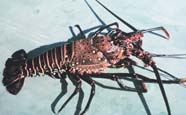
The carapace is the hard shell covering of the cephalothorax of this spiny lobster.
|
carapace - a hard shield, or shell covering, found over all or part of the anterior dorsal portion of an animal. In lobsters, shrimps, crayfish, and crabs, the carapace is the part of the exoskeleton that covers the head and thorax and protects the dorsal and lateral surfaces. In many crustaceans, the term carapace is also used to describe the hard, protective covering of the cephalothorax, as that of the horseshoe crab. The carapace of a turtle's shell is composed of expanded ribs and vertebrae overlain by dermal plates and horny scales |
carbohydrase - an enzyme that acts upon a carbohydrate |
carbohydrates - organic compounds composed of carbon, oxygen, and hydrogen; includes the simple sugars, double sugars, and complex sugars (starches) |
carbon cycle - the cycling of carbon in the form of carbon dioxide, carbonates, organic compounds, etc., between various reservoirs, e.g., the atmosphere, the oceans, land and marine biota and, on geological time scales, sediments and rocks |
carbon fixation - the conversion of inorganic carbon into organic carbon, usually by photosynthesis |
carbon sequestration - the process of removing atmospheric carbon (carbon dioxide), either through biological processes (e.g., uptake by plants during photosynthesis),or geological processes through storage of carbon dioxide in underground reservoirs |
carbon sink - a reservoir that can absorb or "sequester" carbon dioxide from the atmosphere. Forests are the most common form of sink, as well as soils, peat, permafrost, ocean water and carbonate deposits in the deep ocean. A carbon sink removes more carbon dioxide from the atmosphere than it releases |
carbon-14 - a radioactive isotope of carbon with a half life of 5,730±40 years that is particularly useful for dating carbonaceous materials; also called 14Carbon or radiocarbon |
carbonate - a mineral composed mainly of calcium (Ca) and carbonate (CO3) ions. Carbonates may also include magnesium (Mg), iron (Fe) and others; rock or sediments derived from debris of organic materials composed mainly of calcium and carbonate (e.g., shells, corals, etc.) or from the inorganic precipitation of calcium (and other ions) and carbonate from solution (seawater). For example, limestone or dolomite |
carbonate bank - a narrow, fairly flat, shallow, submarine plateau (measured in tens of meters) of composed of limestone (carbonate rock), e.g., the Bahama Banks |
carbonate compensation depth - the depth in the ocean below which material composed of calcium carbonate (CaCO3) is dissolved and does not accumulate on the sea floor |
carbonate mound - a seabed feature usually constructed from carbonate-producing organisms and current-controlled sedimentation. Carbonate mounds are a unique combination of cold-water coral framework and rubble, sediment deposition, and local hydrodynamic influences |
carbonate platform - a broad, flat, shallow, submarine expanse of carbonate rock. Its size is measured in hundreds of meters |
carboxyl group - the -COOH functional group, acidic in nature, found in all amino acids; the acid group of organic molecules |
carcinogen - a chemical substance that causes cancer |
carcinology - the study of crabs and other crustaceans |
cardinal - deep scarlet red color |

The cardinalfish, Apogon dammermani. (Photo: Richard C. Wass/National Park service)
|
cardinalfish - any species of bony fishes in the family Apogonidae. Cardinal fishes are often brightly colored with attractive patterns, usually in shades of red or brown. Most are small tropical marine species, although some live in brackish and even fresh water waters |
Caribbean Coral Reef Institute (CCRI) - NOAA's Caribbean Coral Reef Institute (CCRI), inaugurated in May, 2005, is located at the the University of Puerto Rico-Mayaguez. The CCRI focuses exclusively on the acute problems of Caribbean coral reefs. Its main objective is to aid in the management and conservation of Puerto Rico’s coral reefs by providing timely, relevant information to the Puerto Rico Department of Natural and Environmental Resources and the scientific community at large. CCRI projects include conducting habitat mapping of the western shelf of Puerto Rico, assessing the status of reef resources, and assessing fishery impacts |
Caribbean Decision Support System (CDSS) - a tool developed by the Nature Conservancy and its partners to improve the linkage between biodiversity conservation objectives and human development-related programs such as disaster mitigation/response/planning, economic growth (especially tourism and fishing), and land and water use planning. It represents a comprehensive database of biodiversity and socio-economic information in existence for the Greater Caribbean basin |
Caribbean Regional Association (CaRA) - the National Oceanic and Atmospheric Administration, NOAA, has provided funding to the CaRA to establish and administer a sustained observing system for the northeastern Caribbean region, the Caribbean Regional Integrated Coastal Ocean Observing System (CaRICOOS) to provide observations and products for the purposes of detecting and predicting climate variability and consequences, preserving and restoring healthy marine ecosystems, ensuring human health, managing resources, facilitating safe and efficient marine transportation,coastal Hazard Management Response, and predicting and mitigating against coastal hazards |
CARICOMP (Caribbean Coastal Marine Productivity) - a regional coral reef, seagrass and mangrove monitoring program and network involving a number of Caribbean laboratories, parks and reserves to study land-sea interaction processes in the wider Caribbean region. Twenty-seven institutions in 17 countries participate in CARICOMP |
caridean shrimp - caridean shrimps can be distinguished from other shrimp-like creatures by the way in which the plate of the second abdominal segment overlaps the segments both in front and behind, forming a saddle. They are found in marine, brackish and freshwater habitats from the tropics to the polar regions. Carideans are taxonomically and ecologically diverse, with many remarkable adaptations for survival and reproduction.These crustaceans are placed in the infraorder Caridea, order Decapoda, and class Malacostraca |
carina - any elevated ridge or keel-like structure |
carinate - shaped liked a keel or ridge |
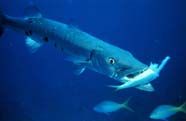
A carnivore (barracuda) caught in the act.
|
carnivore - an organism that feeds upon animals |
Caroline Islands - a large archipelago of about 500 small coral islands, widely scattered in the western Pacific Ocean, east of the Philippines. They are politically divided between the Federated States of Micronesia in the eastern part of the group, and Palau at the extreme western end. The largest islands are Palau (Belau), Yap , Chuuk (truk), Pohnpei (Ponape), and Kosrae |
carotene - a red, orange, or yellow pigment belonging to the group of carotenoids; a precursor of vitamin A |
carotenoid - any of a group of red, orange, and yellow accessory pigments of plants or algae |
carpogonium - the female gamete-producing reproductive organ in red algae, consisting of a single cell and its extension, the trichogyne |
carposporangium - a single-celled structure in red algae that produces diploid carpospores on the carposporophyte |
carpospore - a non-motile diploid spore formed on the carposporophyte stage of the red algae life cycle which germinates to form the tetrasporophyte stage |
carposporophyte - the diploid stage of red algae which develops after fertilization of the carpogonium |
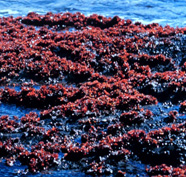
Carrageenan is an extract from red seaweed, mainly Chrondus crispus (Irish moss). (Photo: NOAA/NERR)
|
carrageenan - a water-soluble polysaccharide extracted from red seaweed, mainly Chrondus crispus (Irish moss). It is used in both cosmetic and food applications as a stabilizer and emulsifier capable of controlling viscosity, maintaining product integrity, and for giving an improved mouthfeel and body to foods. Carrageenan is a commonly used ingredient in toothpaste, ice cream, dry mixes, desserts, milk products, tomato sauces, salad dressings, and cheese products |
carrier cell - in sponges, a migratory choanocyte that transports sperm to the oocyte |
carrion - the dead and rotting body of an animal; carrion is food for scavenging animals |
CARRUS Alliance (Comparative Analysis of Reef Resilience Under Stress Alliance) - the CARRUS Alliance was organized at the 2004 International Coral Reef Symposium held in Okinawa. Its objective is to provide a basis for better understanding of coral reefs at the scale of the whole reef system. The Alliance consists of researchers conducting independently-supported long-term, interdisciplinary research on whole reef systems, including associated social and economic systems, united through agreements for the exchange of information, methods, expertise, and software. One focus of the Alliance will be on developing common research objectives, including the development of decision support systems to facilitate reef management. The Alliance will be linked to a variety of international efforts |
carrying capacity - the maximum population size that can be regularly sustained by an environment; the point where the population size levels off in the logistic growth model |
Cartagena Convention: Convention for the Protection and Development of the Marine Environment of the Wider Caribbean Region - the "Convention area" means the marine environment of the Gulf of Mexico, the Caribbean Sea and the areas of the Atlantic Ocean adjacent thereto, south of 30 deg north latitude and within 200 nautical miles of the Atlantic coasts of the States referred to in article 25 of the Convention. The Cartagena Convention was adopted on 24 March 1983 and entered into force on 11 October 1986 as the legal instrument for the implementation of the Caribbean Action Program. It is a regional framework agreement negotiated under the auspices of the Regional Seas Program of the United Nations Environment Program (UNEP). It sets out general legal obligations to protect the marine environment of the Gulf of Mexico, Straits of Florida, Caribbean Sea, and immediately adjacent areas of the Atlantic Ocean -- collectively known as the Wider Caribbean Region. The United States became a Party to the Cartagena Convention in 1984. The Convention and its three Protocols constitute a legal commitment by the participating governments to protect, develop and manage their common waters individually or jointly. The Convention is a framework agreement setting out the political and legal foundations for actions to be developed. These actions are directed by a series of operational Protocols designed to address special issues and to initiate concrete actions. The three protocols supporting the Convention are the Oil Spill Protocol, the Specially Protected Areas and Wildlife Protocol (SPAW), and the Land Based Spills Protocol (LBS). RAC/REMPEITC-Carib is the Regional Activity Center established under the Oil Spill Protocol |
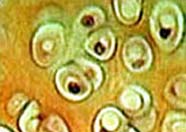
A microscopic section of hyaline cartilage. The cartilage cells (chondrocytes) exist in little cavities (lacunae) in the smooth, glassy cartilaginous matrix. (Photo: NIH/National Cancer Institute)
|
cartilage - a type of connective tissue where the functional component is the rubbery intercellular matrix that is secreted by cartilage-producing cells called chondrocytes. Cartilage exists in several forms, from glassy to fibrous in appearance |
cartilagenous - pertaining to or composed of cartilage; of the consistence of cartilage or gristle |
cartography - the science, technology, and art of making maps and charts. Cartography includes all the steps necessary to produce a map: planning, aerial photography, drafting, editing, color separation, and multicolored printing |
caruncle - a fleshy outgrowth |
CASI (Compact Airborne Spectrographic Imager) - a digital airborne multispectral sensor |
cast net - a circular net with weights attached to the perimeter |
catabolism - a destructive metabolic process by which organisms convert substances into excreted compounds |

The American eel is a catadromous species that spawns in the ocean, near the Sargasso Sea, but grows to maturity in freshwater streams.
|
catadromous species - a species that spawns in the ocean but lives parts of its life in fresh water, e.g., American eel |
catalysis - the acceleration of a chemical reaction by a catalyst. |
catalyst - a substance that accelerates a chemical reaction, but is not consumed or changed in the process |
catamaran - a type of boat consisting of two hulls joined by a frame. Catamarans can be sail or motor powered |
catastrophe - an event that causes sudden decreases of population size or the entire elimination of subpopulations |
catch per unit effort - the number of fish caught by an amount of effort. Typically, effort is a combination of gear type, gear size, and length of time the gear is used. Catch per unit of effort is often used as a measurement of relative abundance for a particular fish; the total catch divided by the total amount of effort used to harvest the catch |
catchment - the area drained by a river or body of water |
categorical excusion - a category of actions that do not individually, collectively, or cumulatively have a significant effect on the environment and that have been found to have no such effect in procedures adopted by a federal agency in implementation of these regulations and for which, therefore, neither an environmental assessment nor an environmental impact statement is required |
category - in taxonomy, any rank within the classification hierarchy, e.g., family, subfamily, subspecies |
catenation - linking of multiple copies of a macromolecule to each other |
cation - a particle that carries a positive electrical charge. The cation gets this positive charge from losing negatively charged electrons |
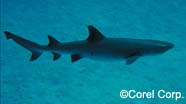
Caudal fin of a shark. The dorsal lobe of the caudal fin is elongated. (Photo: Copyright Corel Corporation)
|
caudal - pertaining to the tail; denoting a position more toward the tail of an animal, e.g., the tail fin of a fish is called the caudal fin. Caudal vertebrae are the vertebrae which extend into the tail of an animal |
caudal fan - in crustaceans, a fan-shaped structure formed by the laterally expanded uropods and telson. The caudal fan functions in swimming, steering and balancing; also called "tailfan" |

The caudal peduncle of the spotted unicorn fish (Naso brevirostris) is located between the anal and caudal fins. (Photo: Copyright Richard C. Wass)
|
caudal peduncle - the narrowest portion of a fish's body, located just posterior to the anal fin and just anterior to the caudal fin |
cay - a small, low coastal island or emergent reef of sand or coral; flat mound of sand and admixed coral fragments built upon a reef flat or just above high tide level. A synonym of key, as in the Florida Keys |
CD-ROM (Compact Disk-Read Only Memory) - an optical medium. A CD-ROM 5.25-inch disk can hold about 650 megabytes of information |
CDHC (Coral Disease and Health Consortium) - in response to the dramatic increase of coral diseases observed over recent years, the U.S. Coral Reef task force (2002) recommended the creation of the CDHC from a cross-section of internationally recognized experts in coral diseases, biomedical and veterinary sciences, pathology, chemistry, biology, biotechnology, and marine management. It organizes and coordinates the scientific resources of the U.S. and its territories to meet the challenge of globally declining coral reefs |
cDNA (complementary DNA) - a strong, cloned DNA copy of otherwise fragile mRNA, made using reverse transcriptase. A cDNA is so-called because its sequence is the complement of the original mRNA sequence. However, when double-stranded cDNA is synthesized, it contains both the original sequence and its complement |
cDNA library - a collection of cDNA clones that were generated in vitro from the mRNA sequences isolated from an organism, or a specific tissue or cell type, or population |
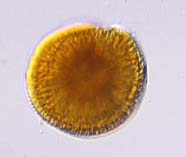
This example of a single-celled organism, the dinoflagellate Gambierdiscus toxicus, produces toxins including ciguatoxin and maitotoxin. The toxins are associated with ciguatera fish poisoning.
|
cell - the smallest unit of living matter. All organisms are composed of cells and cell products (Cell Theory). Organisms exist either as single cells (unicellular) or as multicellular units |
cell adhesion - adherence of cells to surfaces or to other cells |
cell body - the enlarged portion of a neuron which contains most of the organelles |
cell culture - the in vitro growth of cells derived from multicellular organisms. The cells are usually of one type |
cell cycle - the period between the formation of a cell by the division of its parent cell and the formation of two new cells by cell division |
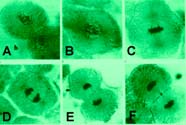
Cell division by mitosis. A-B: Prophase - the replicated (daughter) chromosomes (chromatids) undergo extensive condensation. They are greatly thickened and shortened but are still contained within the nuclear membrane. Prophase ends with the sudden beakdown of the nuclear membrane. C: Metaphase - the replicated chromosomes converge toward the center of the cell. D: Anaphase - sister chromatids split at their centromeres. These daughter chromosomes then begin to separate from each other, and move toward one of the two spindle polar regions. E-F: Telophase/Cytokinesis - Chromatids arrive at opposite poles of cell, and new membranes form around the daughter nuclei. The chromosomes disperse and are no longer visible. Cytokinesis or the partitioning of the cell may also begin during this stage. In animal cells, cytokinesis results when a fiber ring composed of a protein (actin) around the center of the cell contracts and pinches the cell into two daughter cells, each with one identical nucleus. Chromosomal replicaton occurs during the interphase beween mitotic activities. (Photo: Dept. of Biology, University of New Mexico)
|
cell division - the separation of one cell into two daughter cells, involving both nuclear division (karyokinesis) and subsequent cytoplasmic division (cytokinesis). Genetically, the daughter cells are identical to the mother cell (mitosis); however, in gametogenesis (meiosis), the resultant daughter cells (gametes) have the chromosome number reduced by one-half |
cell fusion - the formation of a hybrid cell produced by the fusion of two different cells |
cell line - cells that have been extracted from human or animal tissue and now grow and replicate continuously outside the living organism |
cell membrane - the structure enveloping a cell, enclosing the cytoplasm and forming a selective permeability barrier which permits the passage of solvents and solutes into and out of cells. It consists of lipids, proteins and some carbohydrates |
cell wall - an extracellular material that forms the outer surface of plant, fungus, and certain bacterial cells. It is external to the cell membrane and serves in a structural and supporting role. The cell wall is composed primarily of cellulose and lignin in plants, chitin in Fungi, and peptidoglycans in bacteria |
cellular differentiation - genetically-induced divergence in the structure and function of cells as they become specialized during a multicellular organism's development |
cellular respiration - the transfer of energy in cells by the catabolism of molecules to produce ATP, during which oxygen is consumed and carbon dioxide produced. It occurs in the mitochondria of eukaryotes |
cellulolytic enzyme - an enzyme that acts upon cellulose |
cellulose - a polysaccharide that is composed of unbranched chains of glucose. It is the major structural carbohydrate of plants |
cement - the chemically precipitated calcium carbonate present in spaces within skeletons or between grains of internal sediment |
cement reef - a coral reef created by cementation of essentially in place organisms. Coral cement provides strength and volume to the reef, and can form on non-skeletal as well as skeletonized organisms. The cement buttresses coral reefs, giving them the strength to withstand crashing waves and other onslaughts. Ocean acidification may have deleterious effects on the formation of this cement, as a lower pH reduces the formation of cement binder. The reef's cement binder is made from calcium carbonate that precipitates out of ocean water when it rushes through the pores of coral skeletons |
cementation - the process of deposition of dissolved mineral components in the interstices of sediments or coral skeletons |
cenospecies - species that can interbreed |
Cenozoic - the current geologic era, which began 66.4 million years ago and continues to the present |
census - the enumeration of all the individuals in a population |
Census of Marine Life (CoML)/Census of Coral Reefs (CReefs) Project - a research initiative to conduct a taxonomically diversified census of coral reef ecosystems throughout the globe. This international partnership, led by NOAA’s Pacific Islands Fisheries Science Center, the Australian Institute of Marine Science, Scripps Institution of Oceanography, and the Hawai´i Institute of Marine Biology, will expand tropical taxonomic knowledge (with a particular focus on understudied species), increase the exchange of coral reef ecosystem data dispersed throughout the globe, and develop new and innovative technology and sampling strategies, as well as contribute to the CoML barcode initiative. CReefs plans to work closely with the NOAA Coral Reef Conservation Program (CRCP) and other organizations on outreach and education, collaboration with other existing coral reef efforts, and collection and unification of data into the Ocean Biogeographic Information Center for research, management, and preservation purposes |
center line - the imaginary line running from bow (front) to stern (rear) along the middle of a vessel |
center of genetic diversity - a region where a particular taxonomic group of organisms exhibits greater genetic diversity than it does elsewhere |
center of origin - the area in which a given taxonomic group of organisms originated and from which it has subsequently spread |
Centigrade Temperature Scale - a thermometric scale in which 0 degrees C (Celsius) marks the freezing point of water and 100 degrees C indicates the boiling point of water at sea level |
centiMorgan - the unit of genetic map distance between two loci that show one (1) percent recombination |
centrad - toward the center or interior |
centradenia - a spongy mass formed by the coenosarc in some types of siphonophore colonies, which is partly hepatic in function, and partly excretory |
central chord - the central part of the axis of an octocoral composed of gorgonin or gorgonin permeated with calcareous material |
Central Dogma (of molecular biology) - the principal statement of the molecular basis of gene action. Genetic information is stored in and transmitted as DNA. Genes are expressed by being copied as RNA ( transcription), which is processed into mRNA (messenger RNA) via splicing and polyadenylation. The information in mRNA is translated into a protein sequence using a genetic code to interpret three-base codons as instructions to add one of twenty amino acids, or to stop translation; or more simply put, DNA carries the genetic information which is transcribed to RNA and subsequently translated to protein. Francis Crick, the co-discoverer of the double helix structure of DNA, coined the term "Central Dogma" in 1958 to characterize the all-important cellular processes whereby DNA is "transcribed" into RNA and RNA is "translated" into protein |
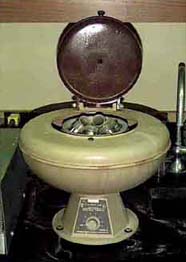
A centrifuge used to "spin down" materials.
|
centrifugation - the spinning of a mixture at very high speeds to separate substances of different densities |
centriole - one of two small cylindrical cell organelles composed of nine triplet microtubules. They form the asters during cell division |
centrolecithal - a type of egg cell that has its yolk in the very center of the cytoplasm, such that the initial meroblastic cleavage of the zygote happens all around the embryo. Most arthropods have centrolecithal eggs |
centromere - the center part of a chromosome that appears ‘pinched’, in between the short arm (p) and the long arm (q). The centromere holds the two chromatids together, and during cell division (mitosis) it is the site of attachment for the spindle fibers |
centrosome - a granular region of a cell which contains two centrioles and is a center of microtubule organization during the division of the nucleus |
centrum - a center or central mass |
cephalic - pertaining to the head |
cephalization - the localization of neural coordinating centers and sensory organs at the anterior end of the body |
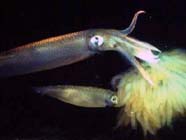
Squid (class Cephalopoda) with egg mass.
|
Cephalopoda - a class of the phylum Mollusca that includes squids, octopods, cuttlefishes and nautili. Many species are inhabitants of coral reefs |
cephalopodium - in cephalopods (octopi, squids) the head region, consisting of head and tentacles; a muscular mass enabling the mollusk to move, with brain and sense organs at the front end, which evolved into a foot for gastropods and bivalves, or into tentacles and funnel for cephalopods |
cephalothorax - the region of the body in decapod crustaceans that is covered by the carapace, with the boundary between the fused head and thorax indicated by the cervical groove. In lobsters, the cephalothorax is called the "body"; in shrimps, it is called the "head" |
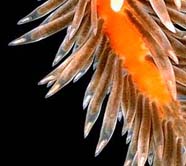
Cerata (plural of ceras) of Aeolidiella foulisi showing the brown duct of the digestive gland and the whitish cnidosac at the tip.
|
ceras - one of many multifunctional horn or lobe-shaped or leaf-like process on the back or side of a nudibranch mollusk (sea slug). It has a major function as a respiratory organ (a gill), and with a branch of the digestive gland, it also serves as an organ for the exchange of gases and other molecules with the blood. The ceras also stores stinging nematocysts in a structure called the cnidosac, from the cnidarians upon which they feed, which gives it a defensive function. Its ability to change color also gives it a protective camouflage function |
cerebral ganglion - in invertebrates, one of a pair of ganglia (or fused median ganglion) situated in the head or anterior portion of the body;also called the the "dorsal ganglion" or " cerebroganglion" |
cerioid growth form - a coral growth form in which the coral colony is composed of corallites united directly to one another by fused walls. The corallites are juxtaposed |
cerulean - dark blue color |
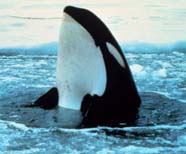
The killer whale is actually a dolphin in the cetacean family, Delphinidae
|
cetacean - a marine mammal of the Order Cetacea. The Cetacea includes whales, dolphins and porpoises |
cf - an abbreviation for the Latin word 'confer', meaning "compare" |
chaeta - a stiff hair or bristle, made of chitin, characteristic of annelid worms. In the earthworm they occur in small groups projecting from the skin in each segment and function in locomotion. The chaetae of marine polychaete worms are borne in larger groups on paddle-like appendages called parapodia |
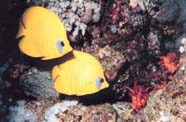
A pair of butterfly fishes (Chaetodontidae). Their presence and behavior serve as biological indicators of reef health.
|
Chaetodontidae - a family of fishes (butterfly fish) whose number and behavior may serve as indicators of reef health |
chain transect - a linear transect where a chain is used to mark the line under study. By following the surface contour of the reef, chain transects provide data that may be used to calculate the estimated spatial index (the ratio of reef surface contour to linear distance of the reef) |
CHAMP (Coral Health And Monitoring Program ) - a NOAA program whose mission is to provide services to help improve and sustain coral reef health throughout the world. Long term goals are: establish an international network of coral reef researchers for the purpose of sharing knowledge and information on coral health and monitoring; provide near real-time data products derived from satellite images and monitoring stations at coral reef areas; provide a data repository for historical data collected from coral reef areas; and add to the general fund of coral reef knowledge |

A duckbill eel in a sand channel. (Photo: NOAA/NURP)
|
channel - a deep and relatively narrow body of water (as in a river, harbor, or a strait linking two larger bodies) that allows the best passage for vessels; an open conduit either naturally or artificially created which periodically or continuously contains moving water, or which forms a connecting link between two bodies of water. River, creek, run, branch, and tributary are some of the terms used to describe natural channels. Canal and floodway are some of the terms used to describe artificial channels. |
character - in taxonomy, any attribute of organisms used for recognizing, differentiating or classifying taxa |
character displacement - the process by which two closely related species, with overlapping ecological requirements, interact so as to cause one or both of them to diverge evolutionarily in one or more traits. They differ more when they co-occur than when they do not |
charismatic megafauna - large animals (usually vertebrates) that evoke sentimental support from the general public, for example, porpoises,seals and sea lions, marine turtles, and manatees |
Charles Law - under conditions of constant pressure and quantity, there is a direct relationship between the volume and absolute temperature for an ideal gas |
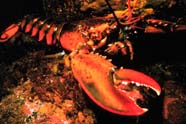
The large pinching claw of this crustacean is the chela. The entire leg bearing the chela is termed the cheliped. (Photo: NOAA)
|
chela - a pinching claw of a decapod crustacean, composed of a moveable finger, the dactylus, and a fixed finger, a distal extension of the propodus |
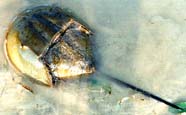
The horseshoe crab is an arthropod in the order Cheliceramorpha
|
Cheliceramorpha - an order of arthropods that includes horseshoe crabs, daddy-longlegs, and extinct "sea-scorpions, spiders and scorpions, mites and ticks, " Most of its marine representatives are extinct, but were prominent in the Paleozoic |
cheliform - pincer-shaped |

A cheliped of this American lobster (Homarus americanus) is a leg bearing a pinching claw.
|
cheliped - one or more pairs of thoracic legs of decapod crustaceans that terminate in a chela, or claw. The entire cheliped is often referred to as a claw |
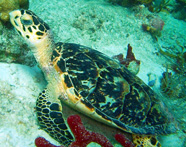
Most turtles, such as this juvenile hawksbill turtle, are members of the reptile family, Cheloniidae (Photo: Becky A. Dayhuf)
|
Cheloniidae - a family of hard-shelled turtles that include the green turtle, loggerhead turtle, hawksbill turtle, leatherback turtle, kemps ridley turtle, olive ridley turtle, and flatback turtle. The leatherback turtle is the only sea turtle not in this family |
chemical bond - the link between two atoms within a molecule. Different types of chemical bonds include hydrogen bonds, covalent bonds, and ionic bonds |
chemical equilibrium - the state in which a chemical reaction proceeds at the same rate as its reverse reaction; the rates of the forward and reverse reactions are equal, and the concentration of the reactants and products stop changing. When this condition is met, there is no change in the proportions of the various compounds involved, and the reaction ceases to progress |
chemical evolution - the chemical changes that transformed simple atoms and molecules into the more complex chemicals needed for the origin of life |

Commercially available light sticks contain a solution in a glass vial. When the vial is broken, a second solution mixes with the first and light (chemiluminescence) is generated. Different dyes give off different colors when they are caused to fluoresce by the light of the chemiluminescent reaction. (Photo: American Chemical Society)
|
chemiluminescence - a chemical reaction that gives off energy in the form of light instead of heat |
chemoautotroph - an organism that utilizes oxidation of inorganic chemicals for its energy and carbon from inorganic carbon dioxide for cell growth; these organisms are also called chemolithotrophs |
chemocline - a sharp gradient in chemical concentration |
chemokinesis - the response by a motile cell to a soluble chemical that involves an increase or decrease in speed, or frequency of movement, or a change in the frequency or magnitude of turning behavior |
chemoorganotroph - an organism that obtains energy from the oxidation of organic compounds and cellular carbon from preformed organic compounds |
chemoreceptor - a receptor that is stimulated by the presence of certain chemical substances |

The deep-sea hot-spring environment supports abundant and bizarre sea life, including tube worms, crabs, giant clams, all of which depend upon chemosynthesis for their nutrition. (Photo: USGS)
|
chemosynthesis - the process whereby chemical energy is used to synthesize organic compounds from inorganic compounds, e.g., the oxidation of ammonia to nitrite by nitrifying bacteria |
chemotaxis - a unidirectional response of motile cells or organisms in which the direction of movement is affected by the gradient of a diffusible substance |
chemotrophs - organisms (usually bacteria) that derive energy from inorganic reactions; also known as chemosynthetic organisms |
chi-square - a statistical technique whereby variables are categorized to determine whether a distribution of scores is due to chance or experimental factors |
chi-square distribution - a distribution in which a variable is distributed like the sum of the the squares of any given independent random variable, each of which has a normal distribution with a mean of zero and a variance of one |
chi-square test - a statistical test based on the comparison of a test statistic to a chi-square distribution. It is used to reject or not reject the hypothesis that two or more population distributions do not differ from one another |
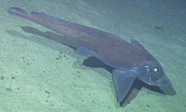
Chimaeras, or ratfish, are closely related to sharks, rays, and skates (Photo:NOAA)
|
chimaera - a cartilagenous fish that has a compressed body and rodent-like teeth. Chimaeras are closely related to sharks and rays (class Chondrichthyes, subclass Holocephali), but have larger heads and eyes, the mouth is more towards the front of the head, the gills are protected by a gill cover, the skin is smooth, and most species have a whip-like tail; also called ghost sharks or ratfish |
chimera - the individual produced by grafting an embryonic part of one individual onto an embryo of either the same or of a different species |
chimeric protein - a human-engineered protein that is encoded by a nucleotide sequence made by splicing together two or more complete or partial genes |
chitin - a polysaccharide made up of chains of N-acetyl-D-glucosamine, a derivative of glucose. Chitin is structurally very similar to cellulose and serves to strengthen the supporting structures of various invertebrates. It also occurs in fungi |
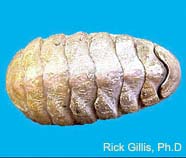
A dorsal view of a chiton shell. Chitons are distinguished from all other mollusks by the presence of their convex shell, which is divided into eight articulating plates (valves). (Photo: Rick Gillis, Ph.D., Biology Dept., University of Wisconsin-La Crosse)
|
chiton - a marine mollusk of the Subclass Polyplacophora, which contains about 600 species of sedentary animals commonly known as chitons.They are found from shallow waters to depths of about 400 m. A chiton has a broad foot and a shell consisting of eight overlapping plates |
chlorocruorin - a greenish iron-containing respiratory pigment dissolved in the blood plasma of certain marine polychaete worms. It may give the green color to the blood of these worms |
chlorofluorocarbons (CFC) - gases that can be dissociated by solar radiation, which release chlorine, which in turn destroys ozone |
chlorophyll - a green pigment present in green plants and cyanobacteria. Chlorophyll is essential in the transformation of light energy to chemical energy in photosynthesis |
chlorophyll a - the major photosynthetic pigment found in all oxygen-evolving photosynthetic organisms (higher plants, and red and green algae) |
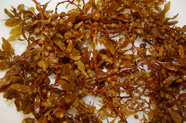
Cells of brown algae, such as Sargassum, do not contain chlorophyll b.(Photo: of H. Scott Meister)
|
chlorophyll b - the chlorophyll generally characteristic of higher plants and green algae. It is absent in other types of algae |
chlorophyll c - the chlorophyll present in brown algae, diatoms, and flagellates |
chlorophyll d - the chlorophyll present in red algae, together with chlorophyll a |
chloroplast - a disk-like organelle with a double membrane, found in some protists and all green plant cells, that contains chlorophyll and is the site of photosynthesis |
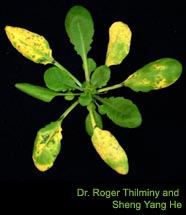
Disease symptoms (necrotic lesions surrounded by chlorosis) caused by a bacterial infection. (Photo: Dr. Roger Thilminy and Sheng Yang He, Michigan State University)
|
chlorosis - the yellowing or bleaching of plant tissues due to the loss of chlorophyll or failure of chlorophyll synthesis. It can be caused by insuffient light or nutrients, and also by certain diseases |
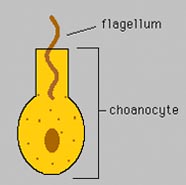
Diagram of choanocyte. The flagella create water currents that bring nutrients into the interior of a sponge. (Diagram: U.S. Environmental Protection Agency)
|
choanocyte (collar cell) - a flagellated cell that lines the interior of the central cavity (spongocoel) of a sponge. Choanocytes have a tubular collar with an extended flagellum that faces the spongocoel and creates currents that force water into the interstices of the sponge. Suspended food particles, such as plankton, are trapped by the choanocytes and passed to an amoebocyte that carries the food to other cells |
choanocyte chamber - in sponges, a cavity lined with choanocytes and located between incurrent and excurrent systems |
choanoderm - in sponges, a surface lined with choanocytes |
choanosome - the internal region of a sponge, including the choanocyte chambers |

A manta ray, a member of the class Chondrichtyes. (Photo: NOAA)
|
Chondrichthyes - the class of cartilaginous fishes that includes sharks, rays, skates, and chimaeras. Their skeleton is composed of cartilage, not bone |
Chondrophora - an invalid name for the cnidarian family Porpitidae.There are only two accepted genera of Porpitids, Porpita, and Velella, which resembles Porpita but has a keel-like "sail" on its aboral surface:also known as "chondrophorina" |
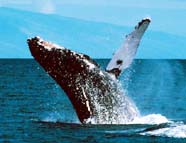
The phylum Chordata includes the mammals such as this large humback whale (Megaptera novaeangliae).
|
Chordata - an animal phylum that includes sea squirts (tunicates), lampreys and hagfishes, fishes, amphibians, reptiles, birds and mammals. Many species of marine chordates play prominent roles in the ecology of coral reef ecosystems |
chorion - a thick, vascularized extra-embryonic membrane of amniote embryos that forms around the entire undersurface of the eggshell in birds and reptiles, and in direct contact with the uterine wall in mammals. It unites with the allantois to form the major structure for exchange between the embryo and the outside (birds and reptiles) or the maternal circulation (mammals) |
chorology - the study of the spatial distribution of organisms |
chory - a suffix meaning plant dispersal by a specified agency (animals, wind, water, etc) |
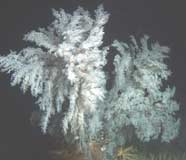
Christmas tree coral (Antipathes dendrochristos) photographed during surveys of deepwater rocky banks off southern California.(Photo: Mark Amend/NOAA)
|
Christmas tree coral - a recently discovered (2002) deep water black coral (Antipathes dendrochristos) observed on deep rocky banks off southern California.The species, which was described in 2005, forms bushy colonies that grow up to to three meters in height and width, and resembles ornamented Christmas trees. Like many other deep water corals, Christmas tree corals support a diverse biological assemblage |
chromatid - each of a pair of identical DNA molecules after DNA replication, joined at the centromere |
chromatin - replicated DNA and associated proteins; highly folded ribbon-like complexes of deoxyribonucleic acid (DNA) and a class of proteins called histones; protein/DNA complex making the chromosome |
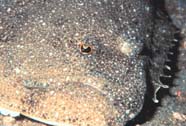
This flounder is rarely noticed unless disturbed because of its remarkable ability to change color to match the substrate, by concentating or dispersing pigment granules in its chromatophores.
|
chromatophore - a cell whose cytoplasm contains pigment granules that can be rapidly concentrated or dispersed, producing an overall effect of altering the color, color pattern or tone of the whole or part of an animal |
chromocyte - a pigmented cell |
chromoplast - a plastid containing pigments other than chlorophyll, usually yellow or orange carotenoids |
chromosomal aberration - any change in chromosome structure or number. Although chromosomal abberations can be mechanisms for enhancing genetic diversity, such alterations are usually deleterious or ill-adaptive; includes deficiency, duplication, inversion, translocation, aneuploidy, polyploidy, or any other change from the normal pattern |
chromosomal deletion - a mutation resulting from the loss of a small segment of DNA |
chromosomal mutation - a mutation involving a long segment of DNA. These mutations can involve deletions, insertions, or inversions of sections of DNA. In some cases, deleted sections may attach to other chromosomes, disrupting both the chromosomes that loses the DNA and the one that gains it; any type of change in the chromosome structure or number |
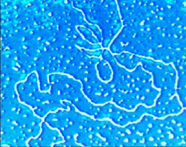
Highly magnified view of cell chromosomes.
|
chromosome - one of the threadlike "packages" of genes and other DNA in the nucleus of a cell. Different species of organisms have different numbers of chromosomes. In sexually reproducing species, each parent contributes one chromosome of each pair, so offspring get half of their chromosomes from the maternal parent and half from the paternal parent. Bacterial cells do not possess a nucleus, therefore their chromosomes are located in the cellular cytoplasm |
chromosome aberration - changes in chromosome structure or chromosome number |
chronic - long term or frequently recurring |
chronobiology - the field of biology concerned with the timing of biological events, especially repetitive or cyclic phenomena in individual organisms. |
chronograph - an instrument for recording the moment of an event |
chronology - the age-depth relationship in ice, sediment, or another deposit. Ages are usually measured for discrete samples, and the ages of intermediate samples are interpolated between samples with measured ages |
chronometer - an instrument for measuring time |
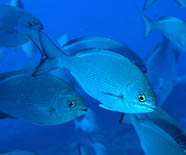
The grey chub, Kyphosus sandwicensis, is a schooling species that is usually found in shallow rocky areas throughout the Indo-Pacific. (Photo: James Watt)
|
chub - any species of bony fishes in the family Kyphosidae. Chubs have compressed oval bodies with small heads.They have small mouths with fine teeth and feed mainly on algae; some are carnivorous, feeding on benthic invertebrates. They congregate in great numbers for pelagic spawning. Kyphosids are distributed in the temperate and tropical inshore waters of the Atlantic, Indian and Pacific Oceans, where they are also known as sea chubs, pilotfishes, rudderfishes, drummers, and by other common names |
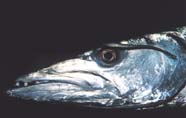
Ciguatera food poisoning may be contracted by eating the flesh of a contaminated barracuda.
|
ciguatera - a food poisoning of humans caused by eating some species of tropical fishes whose flesh is contaminated with toxins obtained through the food chain |
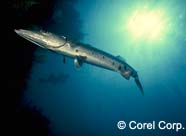
Barracuda (Sphyraena sp.) are often the culprits in ciguatera food poisoning, caused by ciguatoxin. (Photo: Copyright Corel Corporation)
|
ciguatoxin - a toxin found in flesh of marine animals, especially some fishes, at some times, in some localities. It is probably of algal origin and causes paresthesia, gastrointestinal symptoms, neuromuscular blockade, and respiratory paralysis due to interference with membrane function |
cilia - short, motile, generally microscopic, hairlike projections found on many protists and larvae of some invertebrates. Cilia are used for locomotion, the generation of a current, or filter feeding; �A cilium is made up of microtubules and has basically the same internal structure as a flagellum. Movement is caused by the interactions of the microtubules. In higher animals, cilia are found projecting from cells that line certain tubes and passages, such as the tracheae (windpipe) of mammals |
ciliary - relating to any cilia or hairlike processes; can relate to muscles concerned with visual focusing |

Pseudostratified ciliated columnar epithelium - the ciliated epithelium that lines the trachea (windpipe) of mammals. (Photo courtesy of Dr. Franklin S. Carman III, donated from URL: http://tooldoc.wncc.edu)
|
ciliated epithelium - any epithelium having motile cilia on the free surface |
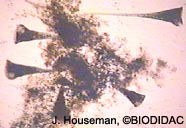
The stalked ciliate, Stentor. (Photo: Jon Houseman/BIODIDAC)
|
Ciliophora - a group of protists bearing cilia |
cinclide - one of many blister-like openings in the lower part of the body column of some anemones, through which the animal expels long, thread-like acontia |
circadian - being, having, characterized by, or occurring in approximately 24 hour periods or cycles |
circadian rhythm - the regular recurrence, in cycles of about 24 hours, of biological processes or activities |
circulatory system - the system that contains the heart and the blood vessels (arteries, capillaries, veins) and moves blood and other circulating fluids throughout an organism's body. This system delivers oxygen and nutrients to the cells, and it helps rid them of waste products. Circulatory systems can be open or closed. Open systems lack capillaries and the blood perfuses through the tissues of the animal’s body. Closed systems have capillary beds which connect arteries and veins. The blood is always contained in a vessel. |
circum - a prefix meaning "around" |
circumesophageal - pertains to structures encircling the esophagus |
circumesophageal commissure - the major commissure (junction) of the nervous system of many invertebrates to which are connected anteriorly and posteriorly directed nerves and nerve chords. It is composed largely of nerve fibers and associated ganglia. This structure encircles the esophagus; also called " nerve ring" |
circumesophageal connective - one of the nerve strand connectives on each side of the esophagus connecting the supraesophageal ganglia and subesophageal ganglia of arthropods, annelids and brachiopods |
circumesophageal nerve ring - anterior concentration of nervous tissue in several invertebrate groups, such as mollusks, annelid worms, sipunculids (peanut worms), and echiurans (spoon worms or innkeeper worms) |
cirrus - a slender, flexible appendage or part of an organism, usually having a tactile function |
cistron - a DNA sequence that codes for a specific polypeptide; an alternate name for a gene |
CITES (Convention on International trade in Endangered Species) - the ‘Washington’ Convention on International trade in Endangered Species of Wild Fauna and Flora, more commonly known as CITES, aims to protect certain plants and animals by regulating and monitoring their international trade to prevent it reaching unsustainable levels. There are more than 150 Parties to the Convention. The CITES Secretariat is administered by the United Nations Environment Programme (UNEP). CITES regulates international trade in over 30,000 species, of which approximately 25,000 are plants |
citric acid cycle - see: Krebs cycle |
clade - a group of species with a common evolutionary ancestry |
cladist - a systematist who attempts to classify life forms according to their evolutionary relationships, not just overall similarity |
cladistic distance - the number of branching points between any two nodes on a phylogenetic tree |
cladistic species - the concept of species in which a species is a lineage of populations between two phylogenetic branch points (speciation events) |
cladistics - the systematic classification of groups of organisms on the basis of the order of their assumed divergence from ancestral species |
cladogenesis - the evolutionary process whereby one species evolves into two or more species |
cladogram - a tree-like diagram, resulting from a cladistic analysis, which depicts a hypothetical branching sequence of lineages leading to the taxa under consideration. The points of branching within a cladogram are called nodes. All taxa occur at the endpoints of the cladogram |
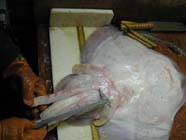
NOAA scientist measuring the length of a rays's clasper.
|
clasper - a rod-like modification of the pelvic fin of a male elasmobranch that is used to transfer sperm into the female during mating |
class - in taxonomy, a category just beneath the phylum and above the order; a group of related orders |

A histogram in which the population of data are grouped into non-overlapping class intervals.
|
class interval - one of the ranges into which data in a frequency distribution table (or histogram) are binned. The ends of a class interval are called class limits, and the middle of an interval is called a class mark. In plotting a histogram, begin by dividing the range of all values into non-overlapping class intervals, in such a way that every piece of data is contained in some class interval |
classical conditioning - a form of associative learning, in which an animal recognizes that two or more events are related. The animal performs a behavior in response to a substitute stimulus rather than the normal stimulus |
classification - a system of nested hierarchical categories used to efficiently store information about biological diversity |
clathrate - resembling an open latticework; a chemical substance consisting of a lattice of one type of molecule trapping and containing a second type of molecule. For example, a clathrate hydrate involves a special type of gas hydrate that consists of water molecules enclosing a trapped gas, such as methane |
Clean Water Act (CWA) - an act passed by the U.S. Congress to control water pollution. Growing public awareness and concern for controlling water pollution led to enactment of the Federal Water Pollution Control Act Amendments of 1972. As amended in 1977, this law became commonly known as the Clean Water Act. The Act established the basic structure for regulating discharges of pollutants into the waters of the United States. It gave EPA the authority to implement pollution control programs such as setting wastewater standards for industry. The Clean Water Act also continued requirements to set water quality standards for all contaminants in surface waters. The Act made it unlawful for any person to discharge any pollutant from a point source into navigable waters, unless a permit was obtained under its provisions. It also funded the construction of sewage treatment plants under the construction grants program and recognized the need for planning to address the critical problems posed by nonpoint source pollution |
cleaner wrasse - a small reef fish of the wrasse family (Labridae) that feeds on ectoparasites of larger "host" fishes. It establishes a "cleaning station" at a specific location on the reef where a variety of host fishes assemble and await the cleaner wrasse's services |
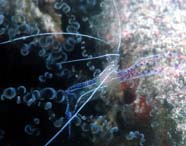
Pederson's Cleaning Shrimp (Periclimenes pedersoni) on a reef in the Virgin Islands. This small (to 1 inch) shrimp favors habitat and a steady food supply offered by Ringed and Giant Caribbean anemones.
|
cleaning behavior - mutualistic behavior in which larger animals, usually fishes, permit smaller animals, usually other species of fishes or invertebrates, to clean them of external parasites |
cleaning station - a site visited by fishes where, in a mutually symbiotic relationship, cleaning shrimp or fish remove parasites from their bodies |
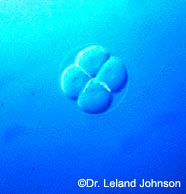
A four-cell stage of a cleaving sea urchin embryo. (Photo: Copyright Dr. Leland Johnson, Augustana College, Illinois)
|
cleavage - the early mitotic cellular divisions of the fertilized egg (zygote) |
CLEO (Coral Literature, Education & Outreach) - the CLEO project is designed to provide easy access to gray literature and pre-1990's literature on the coral reef environments near the Coral Reef Early Warning System (CREWS) monitoring stations to support education, research and management objectives. The Education modules leverage techniques developed at NOAA/AOML in the Explorer of the Seas, Coral Health and Monitoring and CREWS programs under which knowledge transfer of oceanographic instrumentaion and coral reef processes have been developed. Education modules for middle school students engage the students in oceanographic instrumentation, classroom experiments and use of data, and the live Coral Cam observations |
client - a software program that is used to contact and obtain data from a server software program on another computer, often across a great distance. Each client program is designed to work with one or more specific kinds of server programs, and each server requires a specific kind of Client. A web browser is a specific kind of client |
climate - long-term characteristics of weather |
climate change - the long-term fluctuations in temperature, precipitation, wind, and all other aspects of the Earth's climate. It is also defined by the United Nations Convention on Climate Change as "change of climate which is attributed directly or indirectly to human activity that alters the composition of the global atmosphere and which is in addition to natural climate variability observed over comparable time periods" |
climate variability - changes (variability/trends) in the long-term characteristics of weather |
climate-induced bleaching - coral bleaching as a result of changing climate patterns, e.g., temperature |
climax - the final stage in ecological succession that is able to persist in the absence of environmental change |
clinal speciation - a form of allopatric speciation in which a vicariant event interrupts gene flow in a former cline |
cline - the gradual variation, in a character of a species, in geographical space |
cloaca - the common passage for fecal, urinary and reproductive discharge in most lower vertebrates |
CLOD (Coralline Lethal Orange Disease) - a disease which infects coralline algae |
clod card - cards or balls made of plaster of Paris (calcium sulfate hemi-hydrate) or alabaster (calcium sulfate dihydrate). Pre-weighted clod cards are deployed in a benthic or demersal environment to provide an inexpensive method to measure water movement. These clod cards dissolve at a rate related to the shear or rate of mixing, or “scrubbing” applied by a moving fluid to a surface. The higher the shear, the faster a clod card will dissolve. After retrieval, post-deployment weights are compared to pre-deployment weights. The rate and amount of dissolution is related to the relative amount of exchange of nutrients between the benthic community and the water column |
clone - an individual genetically identical to the parent organism, created by the splitting off or budding of cells from the parent organism |
clone cells - a group of genetically identical cells all descended from a single common ancestral cell by mitosis in eukaryotes, or by binary fission in prokaryotes. Clone cells also include populations of recombinant DNA molecules all carrying the same inserted sequence of bases |
cloned DNA - exact copies of DNA segments prepared by using recombinant DNA technology |
cloning - the process of asexual reproduction in an otherwise multicellular organism |
cloning vector - DNA molecule originating from a virus, a plasmid, or the cell of a higher organism into which another DNA fragment of appropriate size can be integrated without loss of the vector's capacity for self-replication; vectors introduce foreign DNA into host cells, where the DNA can be reproduced in large quantities. Examples are plasmids, cosmids, and yeast artificial chromosomes; vectors are often recombinant molecules containing DNA sequences from several sources |
closed circuit scuba - a diving apparatus which allows divers to re-breathe exhaled air after removal of carbon dioxide and addition of supplemental oxygen. It is not generally used by recreational scuba divers |
closed circulatory system - a circulatory system in which blood flows through blood vessels at all times. Blood flows from arteries to capillaries and through veins, but the tissues surrounding the vessels are not directly bathed by blood. Some invertebrates and all vertebrates have closed circulatory systems |
closed system - a system in which no matter or energy can leave or enter from the outside |
Clostridium - a genus of Gram positive anaerobic spore-forming bacteria. Clostridium includes common free-living bacteria as well as important pathogens of humans and marine animals |

A clupeoid fish, the Atlantic thread hering Ophisthonema oglinum (Photo: NOAA)
|
clupeoid fish - any soft-rayed, bony fish species belonging to the order Clupeiformes. These include herrings, shads, wolf herrings, sardines, and anchovies |
clupeoid fish poisoning - a very serious form of fish poisoning caused by eating clupeotoxic fishes; also called clupeotoxism |
clupeotoxic fish - fishes in the orders Clupeiformes (herrings and herring-like fishes), and Elopiformes (ladyfishes and tarpons) whose flesh might contain a toxin, clupeotoxin, by ingesting certain dinoflagellates which contain the toxin |
clupeotoxin - the poison in clupeotoxic fishes. It is a neurotoxin, palytoxin, found in marine dinoflagellates and presumably ingested by the fish |
cluster analysis - a multivariate statistical technique for solving classification problems. The object is to sort items into groups such that the degree of association is strong between members of the same cluster and weak between members of different clusters |
clutch - a group of eggs laid at the same time |
cnida - an organelle located in cnidocytes that is capable of eversion. There are three types of cnidae: nematocysts, spirocysts, and ptychocysts. |
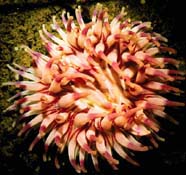
An Atlantic coast cnidarian, a dahlia sea anemone (Tealia sp.) (Photo: Andy Bruckner)
|
Cnidaria - a multicellular animal phylum, with a tissue grade of construction, that contains the stony (hard) corals, anemones, sea fans, sea pens, hydroids, and jellyfish |
cnidocyte - a stinging cell of jellyfish, hydroids, sea anemones and corals. The cnidocyte contains the eversible cnida. The most common type of cnidocyte is the stinging structure also known as the nematocyst or cnidocyst Cnidocytes are located throughout the epidermis, but are especially abundant on the tentacles |
cnidoglandular band - the distal rim or free margin along a cnidarian mesentary |

Section through the ceras of Aeolidiopsis ransoni showing the cnidosac with three nematocysts. (Photo: Dr. Bill Rudman)
|
cnidosac - a sac located in a ceras of a nudibranch gastropod which contains undischarged nematocysts (obtained through feeding upon cnidarians) passed from the slug's digestive system. When a predator attacks the nudibranch, the nematocysts may discharge as a defensive mechanism |
co-adaptation - development and maintenance of advantageous traits benefiting one or both parties in a two-species interaction; evolution of characteristics of two or more species to their mutual advantage; predator-prey and cleaning symbioses are examples of such evolving interactions in marine communities |
co-management - the sharing of authority, responsibility, and benefits between government and local communities in the management of natural resources |
coacervate - an aggregate of colloidal droplets held together by electrostatic forces. Coacervate droplets may contain a mixture of organic compounds. One theory of the evolution of life is that the formation of coacervates in the primeval soup was a step towards the development of cells |
coalesce - to come together so as to form one whole; to fuse |
coarse sediment - a sediment made up of coarse-grained materials, such as sand or gravel particles |

Rainbow over Hawaii, HI coast (Photo: Dr. James P. McVey, NOAA Sea Grant Program)
|
coastal area - the areas of land and sea bordering the shoreline and extending seaward through the breaker zone. Coastal areas throughout the world are under enormous environmental stress, which is caused by a wide range of factors, including pollution and the destruction and deterioration of marine habitats |

A coastal storm leaves flooded streets in its wake. (Photo: U.S. Army Corps of Engineers)
|
coastal flooding - flooding that occurs from storms where water is driven onto land from an adjacent body of water |
coastal margin - the boundary line between land and sea |
coastal morphology - the form and configuration of a coast |
coastal reef - a coral reef occurring near and parallel to a coastline |
Coastal Science, Information and Data for the Ecosystem (C-SIDE) - NOAA's National Coastal Data Development Center (NCDDC/NODC) created the Coastal Science, Information and Data for the Ecosystem (C-SIDE) as a comprehensive storm information center with information about severe weather preparation and monitoring across the Gulf of Mexico coastal region. C-SIDE provides tropical advisories and weather alerts along the major evacuation routes. In addition, C-SIDE provides links to local, state, and national websites that have important information before, during, and after a severe weather event |
coastal waterway - a body of water situated on or near a coast, with some association with the ocean. Includes embayments, wave-and tide-dominated estuaries, wave-and tide-dominated deltas, coastal lagoons, and tidal creeks |
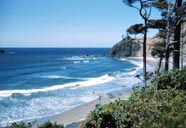
Spectacular Oregon coastline. (Photo: Rear Admiral Harley D. Nygren, NOAA Corps)
|
coastal zone - coastal waters and adjacent lands that exert a measurable influence on the uses of the oceans and their living and nonliving resources |
Coastal Zone Management Act - passed in 1972, the CZMA provides for management of shoreline areas that may include coral reefs |

A single coat protein (capsid) of a cypovirus surrounded by a loose polyhedrin matrix. (Photo: Dr. Hans Ackermann, Medical Faculty, Laval University, Quebec, Canada)
|
coat protein - the coating protein that encloses the nucleic acid core of a viral particle; the capsid |
Coccidea - a class of parasitic single-celled organisms in the protistan phylum, Apicomplexa |
coccoid - spherical in shape |
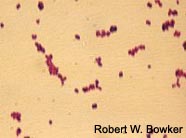
Coccus bacteria. (Photo: Robert W. Bowker, Glendale Community College�Glendale, AZ)
|
coccus - a bacterium with a spherical shape |
COD (Chemical Oxygen Demand) - a measure of the chemically oxidizable material in water which provides an approximation of the amount of organic and reducing material present. The determined value may correlate with biochemical oxygen demand (BOD) or with carbonaceous organic pollution from sewage or industrial wastes |
cod end - the terminal, closed end of a trawl net |
Code - in taxonomy, the International Code of Zoological Nomenclature. An authoritative document containing a system of rules and recommendations to be followed in giving a scientific name to an animal or animal group |
coding - the specification of a peptide sequence by the code contained in DNA molecules |
coding region - a sequence of DNA, bounded by start and stop codons, which consists of a series of nucleotide bases that gives rise to mRNA (messenger RNA) that will be translated into the specific amino acids of the protein product |
coding sequence - that portion of a gene which directly specifies the amino acid sequence of its protein product |
coding strand - the strand of duplex DNA which contains the same base sequence (after substituting Uracil for Thymine) found in the mRNA molecule resulting from transcription of that segment of DNA., known as the sense strand. The mRNA molecule is transcribed from the other strand, known as the template or antisense strand |

RNA codons. A = adenine; C = cytosine; G = guanine; U = uracil. (Diagram: NIH/Human Genome Project)
|
codon - three bases in a DNA or RNA sequence which specify a single amino acid |
coefficient - a number expressing the amount of some change or effect under certain conditions |
coefficient of faunal similarity (CFS) - The CFS compares the fauna of one area with that of another. CFS = 2C/(a+b), where C = the number of species in common between two areas, a = the number of species in the first area, and b = the number of species in the second area. The higher the CFS, the greater the resemblance |
coefficient of variation - in statistics, it refers to the standard deviation of a distribution divided by the distribution's mean, providing a standardized measure of the variation in a distribution, which does not increase simply because the mean itself increases or because the units of measurement change |
Coelenterata - an older name for the phylum Cnidaria |
coelenteron - the gastrovascular (digestive) cavity of a cnidarian or ctenophore |
coelobite - an organism that lives in pores and spaces within a reef |
coeloblastula - a larval form associated with oviparous development, with a cytologically undifferentiated central region, and an even distribution of small flagella. Coeloblastulae are found in sponges, brachiopods and other invertebrate groups |
coelom - an internal fluid-filled body cavity within a coelomate organism. It lies between the gut and the outer body wall, and is lined entirely with tissue (peritoneum) derived from the mesoderm. Most internal organs are located within the coelom. The structure and development of the coelom is an important taxonomic character for recognizing major groups of animals |
coelozoic - living in the lumen of a hollow organ, such as the intestine, gall bladder, urinary tract, etc |
coenecium - a branching tubular network inhabited by pterobranch (Hemichordata) colonies that is secreted from glands in the oral shields of the zooids |
coenenchyme - all of the mesenchymal tissue, perforated with channels, that is common to all polyps of a colonial cnidarian |
coenocline - a sequence of communities along an environmental gradient |
coenosarc - the living tissue of a cnidarian polyp, consisting of the outer, nonciliated epidermis and the inner, ciliated gastrodermis with the thin, acellular meoglea in between. The coenosarc connects the coral polyps of a coral colony. It spreads along the surface of the calcareous exoskeleton |
coenosteum - the common surface of corallum between calices |
coenosteum pit - the point of insertion or commencement of septa in some corals |
coenzyme - an organic nonprotein molecule that binds with the protein molecule to form the active enzyme |
coevolution - a change in the genetic composition of one species (or infraspecific group) in response to a genetic change in another, i.e. two or more species evolving, each in response to the other |
cofactor - a nonprotein substance required for certain enzymes to function. Cofactors can be co-enzymes or metallic ions |
cohort - individuals all of the same age |
cohort - in taxonomy, a taxonomic rank between infraclass and superorder |
cold front - in meteorology, a mass of cold air moving toward a mass of warm air. Strong winds and rain typically accompany a cold front |
cold seep - an area of the ocean floor where hydrogen sulfide, methane, and other hydrocarbon-rich fluid seepage occurs. Cold seeps are distinct from hydrothermal vents. Cold seep's emissions are of the same temperature as the surrounding seawater, whereas hydrothermal vent's emissions are super-heated. Cold seeps constitute a biome which support several endemic species |
cold water - temperature regime usually between 4º – 13º C, and not exceeding 20° C. This is not an exact definition, and is meant only to distinguish between cold-water and tropical warm-water coral environments |
cold-water coral ecosystem - a large aggregation of cold-water corals with their associated fauna in terms of spatial coverage at a given locality |
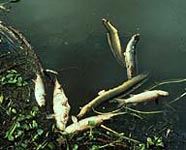
A coliform-caused fish kill. Fecal coliforms originate from sewer overflows, septic tank seepage and animal defecation. They are indicators of fecal contamination which could also contain bacteria and viruses responsible for cholera and typhoid infections, hepatitis and gastroenteritis. (Photo: Pine River Shire Environmental Services, Australia)
|
coliform bacteria - bacteria whose presence in water is an indicator of pollution and of potentially dangerous contamination |
collagen - the protein substance of the collagenous fibers (white fibers) of skin, tendon, bone, cartilage and all other connective tissue. Collagen also serves as skeletal support in some sponges |
collagenous - producing or containing collagen |
collagenous fiber - white connective tissue fiber that occurs in bundles. They possess a high tensile strength and make up the principal element of irregular connective tissue, tendons, and aponeuroses, and occur in the matrix of cartilage and bone tissue |
collar cell - any of the flagellated cells in sponges having a collar of cytoplasm around the flagellum; they maintain a flow of water through the body; a choanocyte; also, a specialized cell found in epithelia of cnidarian mesenterial filaments and the actinopharynx |
collection - an assemblage of specimens compiled and maintained for purposes of study and/or display |
collection - an assemblage of specimens compiled and maintained for purposes of study and/or display |
collenchyme - in cnidarians, mesenchyme with sparse cellular components |
collencytes - a contractile, collagen-secreting amoebocyte in sponges |
collinear - lying on the same line |
collinear points - three or more points on the same line in a plane or in space |
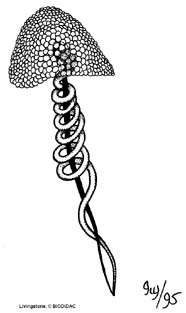
Colloblast discharge organ of ctenophorans (comb jellies). (Image: Livingstone, Copyright BIODIDAC)
|
colloblast - a cell that discharges a sticky filament upon contact with a prey organism. Colloblasts are found in the tentacles of ctenophores (comb jellies). As the tentacles are dragged through the water, the colloblasts discharge and capture prey |
colloid - a stable suspension of particles that, though larger than in a true solution, do not settle out |
colonial - a level of cellular organization intermediate between unicellular and multicellular; refers to organisms that occur in a fixed location, with one generation growing on top previous generations, as in coral reefs; types of animal that are organized into associations of incompletely separated individuals; eg, Portuguese man o' war, sponges and corals; in plants, describes cloning by asexual reproduction in which seemingly separate plants grew from rhizomes, stolons, or roots of a single or neighboring parent plant |
colonial coral - a coral composed of many individuals |
colonial nester - a species that nests in colonies |
colonization - a movement of individuals or propagules of a species to a new territory |
colonized hardbottom - a substrate formed by the deposition of calcium carbonate by reef building and other organisms. Habitats within this category have some colonization by live coral |
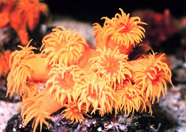
A colony of sun coral polyps (Tubastrea sp). (Photo: Dr. James P. McVey, NOAA)
|
colony - a group of the same kind of animals, plants, or one-celled organisms living or growing together |
color - a quality of light, depending on its wavelength. Perceived color (or visual color) is the quality of light emission as conveyed by the eye, i.e., the visual perception of light that enables humans and other organisms to differentiate between wavelengths of the visible spectrum |

The diver is matching the color of the coral with a color on the CoralWatch color chart. This healthy brain coral is dark brown and has a color score of E6. (Photo: University of Queensland, Australia)
|
color card - the CoralWatch program (University of Queensland, Brisbane, Australia) developed a method of coral health monitoring which uses simple color charts, like paint color matching charts. The color charts are based on the actual colors of bleached and healthy corals. Each color square corresponds to a concentration of symbiotic zooxanthellae contained in the coral tissue. The concentration of symbionts is directly linked to the health of the coral. The color of the coral is matched with one of the colors in the coral health monitoring chart, then the the matching color codes, along with coral type (species if possible) is recorded on a website data sheet (www.coralwatch.org) |
colorimeter - an instrument for measuring and determining color |
coloumb - unit of electrical charge of one ampere over period of one second |
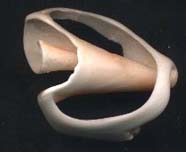
The columella inside a Strombus oyster drill. (Photo: Jesuit Dallas Museum)
|
columella - any small column-like structure in various plants and animals, often forming the central axis of development for the organism as a whole, or an anatomical structure; the thickened axial pillar around which the whorls of gastropods are constructed; the central axis of a corallite; the central structure of the calyx formed by fusion of the septa |
column - the cylindrical body of an anthozoan polyp |
columnar colony - a coral colony formed into one or more columns |
comb row - a longitudinal line of ctenes on the epidermis of ctenophores (comb jellies) |
comb teeth - paddle-shaped projections on the oral pinnules of crinoids |
CoML (Census of marine Life) - a global network of researchers in more than 45 nations engaged in a ten-year initiative to assess and explain the diversity, distribution,and abundance of marine life in the oceans—past, present, and to explain how it changes over time |
commensal - having benefit for one member of a two-species association but neither positive nor negative effect on the other |
commercial extinction - the decline in the population of a wild species, used as a resource, to a level where it is no longer profitable to harvest the species |
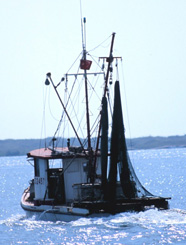
A commercial shrimp boat heading out to the fishing grounds in the Gulf of Mexico. (Photo: William B. Folsom, NMFS)
|
commercial fishing - a term related to the whole process of catching, processing and marketing fishes and shellfish. It also refers to and includes fisheries resources, fishermen, and related businesses directly involved in harvesting, processing or sales |
Commission - refers to the International Commission on Zoological Nomenclature (ICZN) |
commissure - a juncture or seam; the juncture where two sides of a nervous system are joined |
common ancestor - the most recent ancestral form or species from which two different species evolved |
common name - a colloquial or vernacular name. For example, "crown-of-thorns starfish" is the common name of Acanthaster planci |
commonwealth - an organized United States insular area, which has established with the Federal Government, a more highly developed relationship, usually embodied in a written mutual agreement. Currently, two United States insular areas are commonwealths, the Northern Mariana Islands and Puerto Rico. A United States insular area from April 11, 1899, the Philippine Islands achieved commonwealth status on March 24, 1934 (Public Law 73-127), and remained as such until the United States recognized the Philippine Islands' independence and sovereignty as of July 4, 1946 |
communication network - telecommunications infrastructure that transfers data from observing systems to data centers, and then to end users |
community - a naturally occurring assemblage of organisms that live in the same environment and are mutually sustaining and interdependent; a group of populations that interact in time and space |
community-based ecosystem management - a process whereby non-government organizations, community groups, or individuals participate in long-term management of selected species, habitats, or ecosystem processes with the ultimate goal of improving management of ecosystems and natural resources |
compact branching - a growth pattern where the coral branches are close together |
Compact of Free Association - the status of free association recognizes an island government as a sovereign, self-governing state with the capacity to conduct foreign affairs consistent with the terms of the Compact. The Compact places full responsibility for military defense with the United States. The basic relationship of free association continues indefinitely; the economic provisions of the Compact are subject to renegotiation at the end of 15 years |
compensation depth - the depth in the ocean at which the difference between the oxygen produced by algae through photosynthesis and that consumed by them through respiration is zero, i.e., net oxygen production is zero |
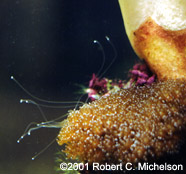
Sweeper tentacles from a Galaxia colony. The stinging cells kill neighboring "non-self" corals in the competion for space. Mesenterial filaments which dissolve neighboring non-self corals are another means of competitive tactics by scleractinian corals. (Photo: Copyright 2001 Robert C. Michelson)
|
competition - a biological interaction that can limit population growth. Competition occurs when two or more populations vie for the same limited resource |
competitive exclusion - the principle that when the populations of two species compete for resources, one will use the resources more efficiently, therefore outcompete and eventually eliminate the other population |
competitive release - the expansion of a species' ecological niche, associated with the lack of competition with other species |
complement - the complement of a nucleic acid sequence replaces each base by its complementary base: adenine (A) by thymine (T), cytosine (C) by guanine (G), and vice versa. In RNA, adenine is paired not with thymine but with uracil (U) |
complementarity - the relationship between the two strands of a double helix of DNA. Thymine in one strand pairs with adenine in the other strand, and cytosine in one strand pairs with guanine in the other strand |
complementary base pair - the specific matching of purine and pyrimidine base pairs in nucleic acids. This matching occurs because the structure of one base precisely fits with, and bonds to, another specific base. In DNA, adenine and thymine are complementary and form a base pair, as do cytosine and guanine. In pairing between DNA and RNA, adenine and uracil are complementary, and cytosine and guanine are complementary |
complementary nucleotide - a member of the pairs adenine-thymine, adenine-uracil, and guanine-cytosine that have the ability to hydrogen bond to one another |
complementary resources - a pair of resources for which consumption by the consumer of one resource reduces its requirement for the other |
complete protein - a protein that has all of the essential amino acids and in the correct proportions |
complex life cycle - a life cycle that consists of several distinct stages (e.g., larva and adult) |
complexity - in ecology, the number of species at each trophic level and the number of trophic levels in a community; in molecular genetics, used to describe a DNA molecule or a mixture of DNA molecules. It is the length of the nucleotide sequence without including any sequence repetition |
compound - a material made up of two or more elements combined in a fixed ratio |
compound chromatophore - a chromatophore that contains more than one kind of pigment |
compound eye - the eye of arthropods, most highly developed in insects and crustaceans. It consists of a group of functionally related visual elements (ommatidia), each having its own refractive system and each forming a portion of an image |
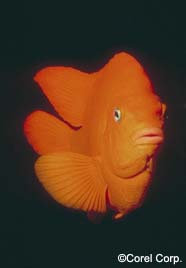
The compressed body shape of a garibaldi. (Photo: Copyright Corel Corporation)
|
compressed - a body shape which is flattened laterally, bringing the right and left sides closer together, e.g., a butterfly fish or a flounder |
compressed air - air compressed to a pressure higher than the surrounding atmospheric pressure (ambient pressure) |
compression - in information technology, decreasing the size of stored information by reducing the representation of the information without significantly diminishing the information itself, usually by removing redundancies. The information requires decompression upon retrieval. Lossless compression allows the original data to be recreated exactly. Lossy compression sacrifices some accuracy to achieve greater compression |
conchiform - shell-shaped |
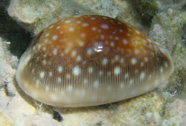
Conchologists study mollusk shells, such as this honey cowry shell, Cypraea helvola. (Photo: Dr. Dwayne Meadows, NOAA)
|
conchology - the study of shells |
conciliatory behavior - behavior directed toward other organisms that tends to diminish or eliminate aggression and promote harmonious social relationships |
confidence interval - the probability, based on statistics, that a number will be between an upper and lower limit |
confluent - joined together |
congener - a member of the same genus |
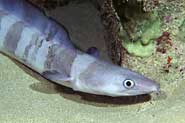
The conger eel,Conger cinereus, is uncommon in Hawaiian waters. It hides under rocks or in caverns and emerges at night (Photo: Keoki and Yuko stender)
|
conger eel - any species of eel in the family Congridae. Conger eels have a thick cylindrical body and tapering snout. They possess a smooth and scaleless skin and large pectoral fins. They are much less common than moray eels in coral reef communities. During the day they tend to hide in crevices and holes under rocks or coral, or burrow into sand. They emerge at night to feed |
conjugated protein - a protein complex combining amino acids with other substances |
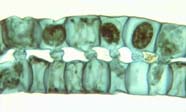
Spirogyra is a filamentous green alga. Certain filaments in a loose parallel bundle of Spirogyra assume the female role, and others the male. The cells of adjacent filaments develop tubular extensions which grow towards one another and eventually fuse to form a continuous tube between the cells. Meanwhile the contents of each cell have formed a round sphere. The spheres from the male filament squeeze their way down the connecting tubes to fuse with a sphere of the female cell in the other filament. The result of this sexual union is the formation of a zygote (zygospore) within the chambers of the female filament. After a dormant period, the zygotes undergo meiosis and germinate, resulting in new filaments. (Photo: Wappinger Schools)
|
conjugation - a process of sexual reproduction whereby two cells come in contact and exchange genetic material. In prokaryotes and unicellular agae, the transfer is a one-way process. The union of two bacterial cells, during which chromosomal material is transferred from the donor to the recipient cell. Conjugation in protozoans is a two-way process, genetic material is passed between each conjugant |
connectivity - natural linkages among reefs including currents, larval dispersal, spawning patterns, and movements of adult organisms. Connectivity is an important part of dispersal and the replenishment of biodiversity on reefs damaged by natural or human-related agents; a qualitative term describing the degree to which ecosystems are linked to one another to form an interconnected network; the movement of organisms from place to place through dispersal or migration |
conopeptide - a family of molecules found in the venom of species of marine cone shell snails (Conus sp) that can act as an analgesic and alleviate pain.One particular group, the omega-conopeptides, blocks channels on nerve cells that transport calcium ions and thereby interfering with the production of neurotransmittors. Synthetic copies of conopeptides from the magician's cone shell, Conus magus, are used to make the drug Prialt, generally known as ziconotide |
Conservation - under the NOAA Coral Reef Conservation program, the term 'conservation' means the use of methods and procedures necessary to preserve or sustain corals and associated species as diverse, viable, and self-perpetuating coral reef ecosystems, including all activities associated with resource management, such as assessment, conservation, protection, restoration, sustainable use, and management of habitat; mapping; habitat monitoring; assistance in the development of management stategies for marine protected areas and marine resourses consistent with the National Marine Sanctuaries Act (16 U.S.C. 1431 et seq.) and the Magnuson-Stevens Fishery Conservation and Management Act (16 U.S.C. 1801 et seq.); law enforcement; conflict resolution initiatives; community outreach and education; and that promote safe and ecologically sound navigation |
conservation - the political/social/economic process by which the environment is protected and resources are used wisely |
conservation biology - a multidisciplinary science that deals with the conservation of genes, species, populations, communities, and ecosystems that make up the Earth's biodiversity. Its goals are to investigate human impacts of biodiversity and to develop approaches to prevent extinction of species through stewardship of entire biological communities |
Conservation Commons - an approach under the World Conservation Union (IUCN) designed to improve the management of data, information, and knowledge related to conservation.It is a collaborative effort to improve open access to data, information, and knowledge related to the conservation and sustainable use of biodiversity with the belief that this will contribute to improving conservation outcomes. Support for this initiative is presently drawn from governments, international and multi-lateral organizations, non-governmental organizations, academia, the private sector, and many other interested parties who share similar goals of ensuring the sustainable use of biodiversity while conserving the integrity of biodiversity for future generations (www.conservationcommons.org) |
Conservation International (CI) - a nonprofit, U.S.-based, international organization that applies innovations in science, economics, policy and community participation to protect the Earth's richest regions of plant and animal diversity in the biodiversity hotspots, high-biodiversity wilderness areas, as well as important marine regions around the globe. With headquarters in Washington, D.C., CI works in more than 40 countries on four continents |
conserved name - in taxonomy, a name otherwise unavailable or invalid that the International Commission on Zoological Nomenclature, by the use of it Plenary Power, has enabled to be used as a valid name by removal of the known obstacles to such use |
consexual - of the same sex |
consolidated rock - tightly bound geologic formation composed of sandstone, limestone, granite, or other rock |
conspecific - of the same species |
consumer - an organism which must consume other organisms (living or dead) in order to satisfy its energy needs |
contaminant - an undesirable substance not normally present, or an usually high concentration of a naturally occurring substance in the environment; a substance in water that might adversely affect the health and welfare of the biota |
Content Standard for Digital Geospatial Metadata - provides a common set of terminology and definitions for the documentation of digital geospatial data. The standard establishes the names of data elements and compound elements (groups of data elements) to be used for these purposes, the definitions of these compound elements and data elements, and information about the values that are to be provided for the data elements |
contiguous - sharing an edge or boundary; touching; neighboring; adjacent |
contiguous habitat - a habitat which shares a boundary with an adjacent habitat |
continental margin - the water-covered edges of continents consisting of the continental shelf, the continental slope, and the continental rise |
continental rise - the enormous wedge of sediment deposited at the base of the continental slope |
continental shelf - the shallow, near-horizontal sea floor extending from the coast to the upper continental slope |
continental slope - the sloping sea bottom of the continental margin that begins at a depth of about 100 to 150 m at the shelf edge and ends at the top of the continental rise or in a deep-sea trench |
continuum - a continuous set of data for which each data point is related to the adjacent point; a gradual or imperceptible intergradation between two or more extreme values |
contour - on a map or chart, a line connecting points of equal surface value |
contour interval - the difference in surface values between contours |
controlled environment - the environment in which parameters, such as light, temperature, salinity, etc., are fully controlled |
controlled experiment - a scientific experiment, in which results from an experimental group with variable conditions, is compared with a control group with nonvariable conditions |
conule - an empty, somewhat conical elevation on the surface of some sponges |
convection - vertical air circulation in which warm air rises and cool air sinks, resulting in vertical transport and mixing of atmospheric properties; transfer of heat by the movement of air or water; the rise of an air mass caused by warming over land or sea that often causes the formation of clouds |
convection current - a movement of air or water caused by changes in density or thermal gradients |
convection precipitation - precipitation which occurs from convective clouds. It falls as showers with rapidly changing intensity. Convective precipitation falls over a certain area for a relatively short time, as convective clouds have limited horizontal extent. Most precipitation in the tropics appears to be convective |
convergence - come together and meet at a point |
convergence zone - the line where two oceanic water masses meet, resulting in the sinking of the denser one |
convergent evolution - the development of superficially similar structures in unrelated organisms, e.g., the wings of insects and birds |
convivium - a population differentiated within a species and isolated geographically, usually subspecies and/or ecotypes; a population or group of organisms that is set apart from other related groups by factors other than interfertility and are maintained by some isolating mechanism other than intersterility. Convivia are usually equivalent to a subspecies or variety |
coordinate taxon - in cladistics, a group within a monophyletic lineage at the same branching level as another. Therefore, it requires equivalent taxonomic rank in the Linnean classification hierarchy |
Coordinating Body on the Seas of East Asia (COBSEA) - the Coordinating Body on the Seas of East Asia (COBSEA) was established in 1981 under the framework of the UNEP Regional Seas Programme with the East Asian Seas (EAS) Action Plan that is basically aimed at establishing a comprehensive strategy to protect the marine and coastal environment of the EAS region and to promote its sustainable development |
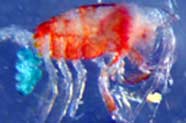
Copepods are very important components of the zooplankton community. This illustration show a copepod carrying a number of eggs (in blue) (Photo: NOAA)
|
copepod - any of a large subclass (Copepoda) of usually minute freshwater and marine crustaceans that form an important element of the zooplankton in the marine environment and in some fresh waters. A common feature uniting all the copepod orders is a single simple eye in the middle of the head, at least in the larval stage. The cephalosome, a shield over the head and some thoracic segments distinguishes the free living forms from parasitic ones. Some species are ectoparasites of marine fishes |
copepodid - postnaupliar developmental stages of copepods |
coprophagous - pertains to feeding on fecal matter |
copulation - the physical act of mating; sexual intercourse |

Finger coral (Porites compressa) in Hawaii (Photo: M. White)
|
coral - a general term used to describe a group of cnidarians; indicates the presence of skeletal material that is embedded in the living tissue or encloses the animal altogether |
coral assemblage - a group of corals |
coral bank - an undersea mound or ridge that rises above the surrounding continental shelf or slope and is formed in part from the carbonate skeletons of corals |
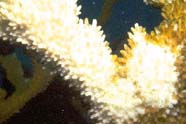
Bleached Acropora coral in Florida Keys (Photo: Larry Benvenuti)
|
coral bleaching - the process in which a coral polyp, under environmental stress, expels its symbiotic zooxanthellae from its body. The affected coral colony appears whitened |

Section of a graphic depicting areas of elevated ocean temperatures that may result in coral bleaching events.
|
coral bleaching hotspot - a region of sea surface temperature (SST) that exceeds the climatological maximum for a region by 1 deg C or more. These conditions may cause sufficient stress to coral reefs to result in coral bleaching |
Coral Bleaching HotSpot monitoring program - a NOAA program that uses satellite and in situ monitoring stations to monitor high sea surface temperature events and to analyze conditions that may lead to coral bleaching |
coral growth line - a minute growth line on the outer surfaces of corals that have a calcified outer wall. The carbonate is produced by zooxanthellae which create a series of diurnal growth increments |
coral holobiont - see "holobiont" |
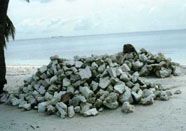
Coral stones and blocks have been used for house construction in many parts of the tropical world. (Photo: Bluepeace/Maldives)
|
coral mining - Corals are mined mainly for the construction of houses and buildings, groins, solid jetties, breakwaters, sea walls, jewelry, decorative ornaments, household furnishings, and aquarium displays. The common species of corals mined are massive corals, such as Porites, which are crushed by manual labor into smaller pieces and used as building materials. Another major use of mined coral is in the making of lime. For many in the tropics, it is cheaper to produce lime locally than buying imported cement. Coral mining methods and techniques are usually manual and labor intensive. Having chosen a suitable reef, miners travel to the site where the corals are dug and broken up with iron bars to manageable sizes, carried to shore, and are left for a period of time to dry and clean. In addition to reducing the number of coral colonies, coral mining reduces the wave absorbing properties of coral reefs. Destruction of the reef exposes the shoreline and coastal communities to storm surges and erosion. Many countries have banned coral mining due to its negative impact on coastlines |
Coral Parks Program (CPP) - a global initiative that supports existing Coral Parks, assists in the establishment on new Coral Parks, and engages divers and the dive industry in coral reef protection. CPP is an initiative of The Coral Reef Alliance, a non-profit organization dedicated to keeping coral reefs alive around the world |
Coral Point Count with Excel extensions (CPCe) - a software program that provides a tool for the estimation of benthic habitat cover using underwater images. The coverage can be analyzed using the random point count method, and areas can also be traced, digitized, and calculated via image calibration |
coral probiotic hypothesis - a concept which posits that a dynamic relationship exists between symbiotic microorganisms and environmental conditions which brings about the selection of the most advantageous coral holobiont (Reshef et al., 2006). Corals exposed to some type of stress, such as unusually high water temperatures, expel their zooxanthellae and then regain a new mixture of zooxanthellae (or other symbiotic microoganisms) that are better suited to the stress conditions |
coral product - any living or dead specimens, parts, or derivatives, or any product containing specimens, parts, or derivatives, of any species of coral in the cnidarian Orders: Antipatharia (black corals), Scleractinia (stony corals), Gorgonacea (horny corals), Stolonifera (organpipe corals and others), Alcyanacea (soft corals), and Coenothecalia (blue coral), of the Class Anthozoa; and all species of the Order Hydrocorallina (fire corals and hydrocorals) of the Class Hydrozoa |
coral recruit - a coral larva which settles onto a suitable substrate to become an addition to the population |

A healthy coral reef in Guam (Photo: David Burdick)
|
coral reef - a wave-resistant structure resulting from cementation processes and the skeletal construction of hermatypic corals, calcareous algae, and other calcium carbonate-secreting organisms |
Coral Reef Alliance (CORAL) - CORAL promotes coral reef conservation around the world by working with the dive industry, governments, local communities and other organizations to protect and manage coral reefs, establish marine parks, fund conservation efforts, and raise public awareness with the mission to keep coral reefs alive for future generation |
coral reef bleaching monitoring product - near real-time information derived from data either from satellite images or in situ monitoring stations at coral reef areas to help improve and sustain coral reef health throughout the world |
Coral Reef Ecosystem Conservation Amendments Act (CRECAA) of 2007 - CRECAA reauthorizes the Coral Reef Conservation Act (CRCA) of 2000 and adds greater protections for coral reefs while enhancing marine debris removal and increasing the government’s ability to work through cooperative partnerships |
Coral Reef Ecosystem Research Plan (NOAA) - the NOAA Research Plan (FY 2007-2011) provides coastal and ocean managers, scientists, and policy makers with the most up-to-date scientific information to address the complex nature of the threats facing coral reef ecosystems, and identifies priority research needed to advance management action. The Research Plan is NOAA’s first agency-wide coral reef ecosystem research plan. Covering all coral reef ecosystems under the jurisdiction of the U.S. and Pacific Freely Associated States, the plan provides a national perspective on the research needed to address the range of stresses affecting the health of coral reef ecosystems, summarizes the management and other issues that will drive research at the regional level, and focuses on the use of research to guide effective implementation of ecosystem-based management strategies |
Coral Reef Ecosystems Studies- Caribbean Program (CRES) - CRES is a core component of NOAA’s Coral Reef Conservation Program. It was initiated in FY 2002 as a science-based, integrated approach to understand coral reef dynamics and processes, and to provide tools, ecosystem forecasts and options for coral reef management strategies in the U.S. Caribbean (Puerto Rico and U.S.Virgin Islands) |
Coral Reef Targeted Research & Capacity Building for Management (CRtr) Project - The GEF-World Bank Coral Reef Targeted Research and Capacity Building Project has been developed to establish an applied investigative framework to support coral reef management and policy. This project has been designed to coordinate investigations, within a limited number of sites around the world, so that priority unknowns can be systematically addressed with the intent of applying the results to management and policy. This project will coordinate investigations over an appropriate time-frame (i.e. 15 years) along major themes of inquiry and then work to appropriately sequence involvement and improve the capacity of how to use such information in meaningful ways, especially within developing countries and small island states. The project supports six thematic working groups (Bleaching and Local Ecological Factors, Connectivity and Large-scale ecological processes, Disease, Restoration and Remediation, Remote Sensing for Coral Reefs, and Modeling and Decision Support), and the project's guiding Synthesis Panel. The Project is executed by a dedicated Project Executing Agency (or PEA) headquartered at the University of Queensland, Australia. However, the project involves a broad range of international partners, such as The World Bank, The Intergovernmental Oceanographic Commission (IOC), NOAA, The WorldFish Center, and a number of academic institutions from around the world |
Coral Reef Watch - see CRW (Coral Reef Watch) Program |
Coral Reef Watch experimental doldrums product - NOAA Coral Reef Watch (CRW) developed an Experimental Doldrums Product that identifies and tracks regions of sustained low wind speed to help coral reef managers and scientists better assess conditions that may lead to coral bleaching. Wind is an important physical factor influencing conditions conducive to coral bleaching. Wind-driven mixing reduces temperature stress and wind generated waves can scatter harmful levels of incoming solar radiation. Periods of sustained low wind may therefore promote environmental conditions adverse to corals experiencing thermal and/or UV stress |
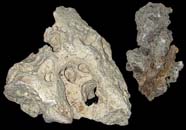
Coral rock for sale in the marine aquarium trade. (Photo: Shell Horizons, Inc.)
|
coral rock - products used in the aquarium trade. Coral rock is consolidated material, greater than 3 cm in diameter, formed of fragments of dead coral and which may also contain cemented sand, coralline algae and other sedimentary rocks. 'Live rock' describes pieces of coral rock to which are attached live specimens of invertebrate species and coralline algae |
coral rubble - fragments of hard coral |
Coral Stress Index - an index that indicates the relative accumulated thermal stress experienced by a given coral reef |
coral triangle - as defined by the Nature Conservancy, the coral triangle spans eastern Indonesia, parts of Malaysia, the Philippines, Papua New Guinea, Timor Leste and the Solomon Islands. It is the global center of marine biodiversity and one of the world’s top priorities for marine conservation. This expanse of ocean covers an area of 2.3 million square miles (5.7 million km2), the equivalent to half of the entire United States. It is home to over 600 reef-building coral species, or 75% of all described coral species, and more than 3,000 species of reef fishes |
Corallimorpharia - an order of the subclass Zoantharia (Hexacorallia) of the phylum Cnidaria. They are mostly solitary species (some are colonial) that resemble true corals, but lack a calcareous skeleton |
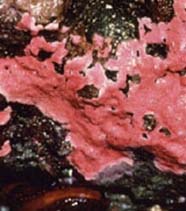
Coralline algae remove calcium from water. This calcium carbonate gives them a coral-like look. As they die, they turn white. (Photo: Nancy Sefton)
|
coralline algae - algae that form solid calcium carbonate accretions |
corallite - a coral cup; the skeleton of an individual polyp |
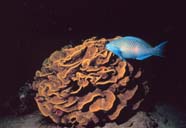
Parrotfish are often coralliverous, scraping the coral polyps with beaklike jaws.
|
corallivore - an organism that eats coral |
corallum - a complete coral colony; a coral head |
cordate - heart-shaped; in the form of two rounded lobes |
CORDIO (Coral Reef Degradation in the Indian Ocean) - CORDIO is an international program created to respond to the degradation of coral reefs throughout the Indian Ocean. In the western Indian Ocean region coral reefs are key ecosystems that support large sectors of the countries' populations and economies, through artisanal fisheries, tourism and large-scale investments. Projects within CORDIO focus on determining a) the biophysical impacts of coral degradation as a result of bleaching and other disturbances, and the long term prospects for recovery, b) the socio-economic impacts of coral mortality and options for mitigating these through management and development of alternative livelihoods, and c) the prospects of restoration and rehabilitation of reefs to accelerate the ecological and economic recovery. |
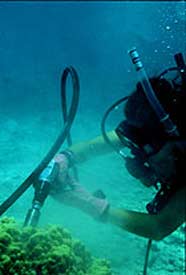
A scientist is taking a coral core using a 1/2 inch pneumatic drill equipped with a 50 cm long hollow steel cutting cylinder. A concrete plug is then tapped into the core hole to seal off the hole. (Photo: Daria Siciliano/ UCSC)
|
core - a cylindrical sample, obtained with a hollow drill, extracted from, inter alia, a seabed, lake bottom, or coral to investigate the composition and depths of layers |
core (geology) - the innermost layer of the Earth, consisting primarily of pure metals such as iron and nickel. The core is the most dense layer of the Earth, and is divided into the outer core, which is believed to be liquid, and the inner core, which is believed to be solid |
COREMO 2 - a data entry and analysis program developed by the southern Indian Ocean Global Coral Reef Monitoring Program (GCRMN) node. It is based on ARMDES (AIMS Reef Monitoring Data Entry System) but has been extensively modified from COREMO to suit the needs of the GCRMN |

The red cornetfish, Fistularia petimba, inhabits coastal areas, usually at depths greater than 10 m. It feeds on small fishes and shrimp. (Photo: Marine Biological laboratory, Woods Hole.)
|
cornetfish - any species of spiny-rayed fishes in the family Fistulariidae. Cornetfishes are elongated, depressed-bodied fishes with a greatly extended tubular snout, a very small mouth, and a long thin filament extending from the middle of the caudal fin. They are closely related to the trumpetfishes (Aulostomidae) which are more robust and lack the caudal filament. At present there are approximately five known species of cornetfishes |
cornute - horn or cup-shaped |
correlate - to show a relationship between entities |
correlation - a relation between a variable and one or more related variables |
correlation coefficient - a measure of the relationship between variables |
correlogram - a graph illustrating the auto-correlations between members of a time series (vertical axis) for different separations in time (horizontal axis) |
corridor - a route that allows movement of individuals or taxa from one region or place to another; in terms of conservation biology, a connection between habitat fragments in a fragmented landscape |
corrugated - having a surface with alternating parallel ridges and grooves |
cortex - the outer portion (layer) of an organ |
corticocyte - in octocorals, a cell that secretes gorgonin, which forms the axis of a gorgonian |
CoRViL (Coral Reef Virtual Laboratory) - a joint venture of the National Oceanic and Atmospheric Administration (NOAA), the Great Barrier Reef Marine Park Authority (GBRMPA), and the Australian Institute of Marine Science (AIMS). This venture will provide an automated, cooperative exchange of electronic data, computer processing power and remote sensing tools for the purpose of monitoring the coral reef environment on the Great Barrier Reef. It is anticipated that this effort will eventually provide a model for monitoring physical processes at other sensitive coral reef areas throughout the world |
corymbose - describes coral colonies with horizontal interlocking branches and short upright branches |
cosmid - a DNA vector that allows the insertion of long fragments of DNA (up to 50 kbases) |
cosmopolitan - having a global distribution |
cosmopolitan distribution - worldwide distribution within habitat limits |
cost-benefit analysis - an assessment of the short-term and long-term costs (losses) and benefits (gains) that arise from an economic decision. If the calculated benefits exceed the calculated costs, the decision to buy an economic good or provide a public good is considered profitable |
costa - the extension of the septa outside the calyx into the coenosteum |
coulombmeter - an instrument for measuring electric charge |

A Coulter counter is an instrument used to measure the distribution of particle size.
|
Coulter counter - an instrument that measures particle size distribution from the change in electrical conductivity as particles flow through a small opening |
counter current - a secondary current flowing in a direction opposite to that of the main current |
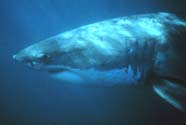
Counter shading in a white shark. The darker dorsal surface and lighter ventral surface allows the shark to blend in with the environment when viewed from above or below. (Photo: NOAA)
|
counter shading - protective body coloration where the dorsal surface (above) is dark and the ventral surface (below) is lighter |
counter-illumination - a condition in which an animal has bioluminescent structures concentrated on its ventral surface so as to increase the effect of countershading |
courtship behavior - specialized behavior patterns which contribute to the psychological and physiological synchronization of potential mating partners |
covalence - the number of pairs of electrons an atom can share with other atoms |
covalent bond - a bond between two or more atoms that is provided by electrons that travel between the atoms' nuclei, holding them together but keeping them a stable distance apart |
cove - a small sheltered indentation in the shoreline. A cove is smaller than a bay |
CRAG (American Samoa Coral Reef Advisory Group) - CRAG administers American Samoa's Coral Reef Initiative (CRI) and is an interagency task force representing five agencies in the Territory, all of which have some link to the coral reef environment. CRAG member agencies work together by mutual consensus to manage coral reefs in American Samoa by planning achievable programs, identifying and collaborating with other partners, obtaining funding for projects, tracking project compliance, promoting public awareness, and developing local capacity for eventual self-sustainability |
craggy - a surface which is rocky and steep |
craterform - massive shape with a broad base and a large, central depression |
crawl - tracks and other signs left on a beach by a seaturtle |
Creefs (Census of Coral Reefs) - a global census of coral reefs, CReefs is one of 17 projects of the Census of Marine Life, an international network of over 1,700 researchers in more than 70 nations engaged in a 10-year initiative to assess and explain the diversity,distribution, and abundance of marine life in the oceans and how it changes over time |
creel survey - a survey of anglers in a particular area to discover the types and numbers of fish caught |
CREIOS (Coral Reef Ecosystems Integrated Observing System) - NOAA's Coral Reef Ecosystem Integrated Observing System (CREIOS) provides a diverse suite of long-term ecological and environmental observations and information products over a broad range of spatial and temporal scales. The CREIOS goal is to understand the condition and health of, and processes influencing, coral reef ecosystems, to assist stakeholders in making improved and timely ecosystem-based management decisions to conserve coral reefs |
crenulate - a shape in which the edge is slightly scalloped |
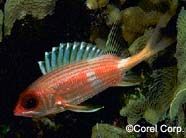
The large eyes of a squirrelfish hint about its crepuscular behavior, allowing it to be active and feed during periods of diminished light. (Photo: Copyright Corel Corporation)
|
crepuscular - most active at low light levels during dusk and dawn |
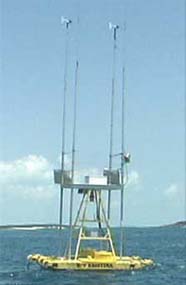
A CREWS station on site.
|
CREWS (Coral Reef Early Warning System) - in situ NOAA meteorological and oceanographic monitoring sites that collect data continuously which are transmitted hourly via satellite to a data archival site. An automated system (hardware and software) that monitors select oceanographic and meteorological parameters and produces specialized alerts when conditions may result in environmental stresses conducive of coral bleaching. NOAA plans to expand the CREWS from the Florida Keys/Bahamian sites to many remote coral reef sites throughout the world |
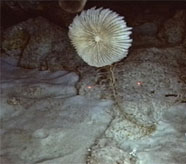
A sea lilly (Crinoidea) is a stalked, usually sessile, echinoderm. This sea lilly was observed off Grand Bahama Island at a depth of about 1200 feet. (Photo: T. K. Baumiller and C. G. Messing/Harbor Branch Oceanographic Institution)
|
Crinoidea - a small class of ancient echinoderms (sea lillies and feather stars) which number about 600 species. All are suspension-feeders, occupying deep parts of the oceans to just below the shoreline. Some are common on coral reefs. Crinoids have long, slender arms arranged radially around a rigid, calcareous, cuplike structure, the calyx. Two basic adult body types are recognized: the sea lilies, with a long, anchored stem vertically supporting the calyx and arms above the sea bottom; and the stemless featherstars, or comatulids, with a whorl of flexible appendages on the calyx |
CRISP (Coral Reef Initiative for the South Pacific) - a French coral reef conservation and sustainable management initiative designed as a vector of regional integration between the developed and developing countries of the Pacific. CRISP pursues the following objectives: gaining a better understanding of coral ecosystems in terms of their biodiversity, current status and functioning; conducting operations to protect and manage coral ecosystems on a broad scale; promoting economic potential based on the biodiversity and use values of coral ecosystems; and sharing information and knowledge, building capacities; and managing local, national and international networks throughout the Pacific |
criterion - a standard rule or test on which a judgment or decision can be based. |
critical depth - the depth in seawater below which carbon loss through respiration by phytoplankton exceeds carbon gain through photosynthesis; no net phytoplankton production occurs |
critical habitat - the ecosystem upon which endangered and threatened species depend; habitat crucial to the survival of the species; The Endangered Species Act (ESA) defines“critical habitat” as specific areas within the geographical area occupied by the species at the time of listing, that contain the physical or biological features essential to the species’ conservation and which may require special management considerations or protection; and specific areas outside the geographical area occupied by the species if the agency determines that the area is essential for conservation |
critical value - in statistics, the value of a test statistic at or beyond which the null hypothesis is rejected |
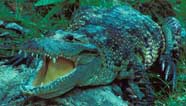
Morelet's crocodiles (Crocodylus moreletii) live primarily in freshwater areas such as swamps and marshes and can also be found in forested riparian habitats.(Photo: Jerry Gingerich )
|
crocodile - in addition to freshwater environments, crocodiles also inhabit brackish waters and coral reef habitats. The American crocodile can be found on offshore cayes and atolls, and in mainland coastal habitats. Two endangered species of crocodile, the American crocodile (Crocodylus acutus) and Morelet's crocodile (Crocodylus moreletii), occur in Belize. The largest American crocodile population (less than 300) in Belize is found in the Turneffe Atoll, which is one of the largest remaining nesting areas in the Caribbean. Morelet's crocodile can be found in brackish water around coastal areas. The saltwater crocodile (Crocodylus porosus), the world's largest reptile, can be found in coastal, coral reef-rich waters from eastern India and Bangladesh through Southeast Asia to Papua New Guinea and Australia. They occur as far east as the Solomon Islands and Vanuatu |
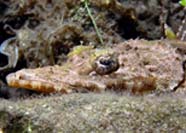
Crocodilefish (Papilluliceps longiceps) in Hurghada, Red Sea. (Photo: Thomas Jundt)
|
crocodilefish - any of about 60 species of bony fishes in the family Platycephalidae. Crocodilefishes have distinct pits immediately behind the eyes and a concave head margin.Their eyes have iris lappets which help break up the black pupil and improve its camouflage. Crocodilefishes are usually found on sandy or rubble bottoms near mangroves, seagrasses or corals |
cross - in genetics, the mating of two individuals or populations |
crossing over - in genetics, the breaking during meiosis of one maternal and one paternal chromosome, the exchange of corresponding sections of DNA, and the rejoining of the chromosomes. This process can result in an exchange of alleles between chromosomes |
crust (geology) - the outermost layer of the Earth, consisting of relatively low-density rocks |
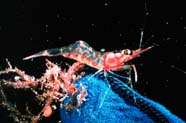
A marine shrimp (Crustacea).
|
Crustacea - a subphylum of Arthropoda that includes shrimp, mantis shrimp, lobsters, crabs, water fleas, copepods, crayfish and wood lice. There are almost 40,000 described species of crustaceans. The Crustacea are mainly aquatic, but include some semi-terrestrial and terrestrial groups |
crustose - grows flat along the substrate; crust-like |
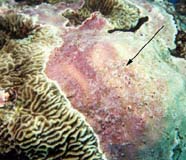
Crustose coralline algae are very common on reefs. (Photo: http://www.botany.hawaii.edu)
|
crustose coralline algae - crustose coralline algae are red algae of the division Rhodophyta. They are very important members of a reef community in which they cement and bind the reef together. They are particularly common in high wave energy areas but can also be found throughout all reef zones. Crustose corallines resemble pink or purple pavement. Morphology can range from smooth and flat, to rough and knobby, or even leafy |
CRW (Coral Reef Watch) program - formed in 2000, NOAA's CRW maximizes NESDIS's coral reef resources by joining and building on existing NESDIS coral reef strengths under a more coordinated program. It seeks to develop a long-term coral reef monitoring system with the ability to predict coral bleaching episodes in all major U.S. coral reef areas |
crypsis - protective camouflage coloration where the individual resembles its backgound |

The viper moray is a cryptic fish, concealing itself in crevices and holes in the coral reef. (Photo: Dr. Anthony Picciolo)
|
cryptic - pertaining to concealment, usually in reference to color pattern or behavior (e.g., hiding in reef crevices) |
cryptobiosis - a suspension of life processes when conditions become unfavorable. In these resistant states some animals, such nematodes, rotifers and tardigrades, as can survive extreme drying, heat, or cold, and then return to "life" when favorable conditions return |
cryptogenic - of obscure or unknown origin |
cryptogenic species - species whose endemic or alien status is unclear. For many species, data are lacking on their original geographic distribution, and it cannot be determined whether they are native or introduced into a particular location |

Light refracts off the ctenes of the comb-jelly Mertensia ovum producing stripes of rainbow color. (Photo: Kevin Raskoff, MBARI.)
|
ctene - the locomotor structure of ctenophores (comb jellies) made up of cilia arranged into flattened plates. The ctenes are arranged into eight longidutinal bands, from the aboral to the oral surface |
ctenidium - a comb-like structure; the respiratory organ of a mollusk (ctenidial gill) |
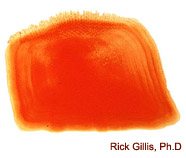
A ctenoid scale of a bony fish. It is thought that the combed edge helps to reduce hydrodynamic drag during swimming. (Photo: Rick Gillis, Ph.D., Biology Dept., University of Wisconsin-La Crosse)
|
ctenoid - comb-shaped; with a comb-like margin |
ctenophore - a member of the animal phylum Ctenophora. A small phylum (about 50 species) whose members, known as comb jellies and sea walnuts, superficially resemble jelly fishes. These planktonic organisms are thought to have evolved from a medusoid cnidarian |

The sea cucumber (Echinodermata) has a cucumiform shape.(Photo: NOAA)
|
cucumiform - cucumber-like form |
cue - in animal behavior, a signal fom one animal which acts as a stimulus to elicit a behavioral response in another. The cue may be visual, acoustic, or chemical |

The cuirass is body armor, particulary aimed at protecting the chest and back. (Photo: Institut et Musée des Suisses dans le Monde)
|
cuirass - a protective covering, such as a cuticle, plates, scales or shells |
culling - the selective removal of animals from a population for conservation purposes |
Cultural Heritage Marine Protected Area (MPA) or Zone - MPAs or zones established and managed wholly or in part to protect and understand submerged cultural resources that reflect the nation’s maritime history and traditional cultural connections to the sea. Examples include some national marine sanctuaries, national and state parks, and national historic monuments |
culture - a population of plant or animal cells or microorganisms that is grown under controlled conditions |
culture medium - a substance which contains nutrients and a favorable environment for the in vitro growth of microorganisms and cells |
current - generally, a horizontal movement of water; a body of air, water, etc. that moves in a definite direction; the flow of electricity expressed in amperes |
curvilinear regression - the relation between variables when the regression equation is nonlinear. With nonlinear relations, an intrinsically linear model may be assumed and then data are fitted to the model using polynomial regression i.e., some models are employed that use regression to fit curves instead of straight lines |
curvilinear relationship - a situation that is best represented by something other than a straight line |
cusp - a point or projection on a tooth |
cutaneous - pertaining to the skin |
cuticle - an extracellular, protective external body covering, secreted by the epidermis, of some invertebrate animals, usually composed of fibrous material, such as chitin or collagen; the waxy layer of epidermal cells of plant parts, such as leaves, stems, and fruit |
cuticular pore - a minute pore opening at the surface of the cuticle |
cuttle bone - the internal calcified shell remnant of cuttlefish |
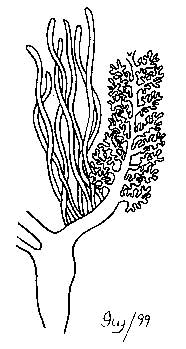
Respiratory tree and the Cuvierian tubules in a sea cucumber (Illustration: BIODIDAC)
|
Cuvierian tubules - clusters of sticky tubules, located at the base of the respiratory tree, which may be discharged by some sea cucumbers (holothurians) when mechanically stimulate, as for example, when being threatened by a predator. Their great adhesivity, combined with their high tensile strength, allows the Cuvierian tubules to entangle and immobilize potential predators with which they come into contact. After expulsion, the lost tubules are readily regenerated, making them a formidable defense mechanism |
cyanide fishing - a destructive fishing technique in which sodium cyanide or some other cyanide compound is used to stun and capture coral reef fishes for the aquarium and live food trade |
cyano- - a prefix denoting blue or dark blue |
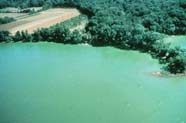
A bloom caused by cyanobacteria (-blue-green algae+).
|
cyanobacteria - photosynthetic aquatic bacteria, often called blue-green algae, but have no relationship to algae. Cyanobacteria get their name from the bluish pigment phycocyanin, which they use to capture light for photosynthesis. They also contain chlorophyll a, the same photosynthetic pigment found in the chloroplasts of plants. Not all "blue-green" bacteria are blue; some common forms are red or pink, resulting from the pigment phycoerythrin |
cyanocyte - a hemocyte that breaks down and releases hemocyanin into the hemolymph |
cyberspace - the whole range of information resources available through computer networks |
cycloid - having a smooth-edged margin |
cyclomorphosis - cyclical changes in form such as seasonal changes in morphology, as seen in some planktonic crustaceans |
cyclone - an area of low pressure. Circulation is counterclockwise around a low pressure system in the Northern Hemisphere and clockwise in the Southern Hemisphere |
cyclonic - refers to a region of low atmospheric sea level pressure; or, the wind system around such a low pressure center that has a clockwise rotation in the Northern Hemisphere and a counterclockwise rotation in the Southern Hemisphere |
cyclosystem - a system of very small tubules that links the polyps of calcareous colonial hydrozoans |
cyclotheonarnide A - a bioactive compound, isolated from a marine sponge Theonella sp., is a potential drug for the treatment of thrombosis, a blood disease in which a blood clot forms in the circulatory system |
cydippid larva - a larva of ctenophores |
cyst - a small, capsule-like sac that encloses an organism in its dormant or larval stage; a fluid-filled sac or vesicle in the body of an animal; a thick-walled resting spore, as in certain algae or fungi |
cystid - the exoskeleton and body wall of the stationary trunk of bryozoans |
cytochrome - a class of protein, found in mitochondrial membranes, whose main function is oxidative phosphorylation of ADP to form ATP; an iron-containing molecule that transfers electrons in metabolic pathways |
cytochrome oxidase - an oxidizing enzyme found in mitochondria of cells. It contains iron and a porphyrin and is important in cellular respiration as an agent of electron transfer from certain cytochrome molecules to oxygen molecules. Cytochrome c is a highly conserved protein found in plants, animals, and many unicellular organisms. This, along with its small size, makes it useful in studies of evolutionary divergence |
cytogenetics - the science that links the study of inheritance (genetics) with that of cells (cytology) and is concerned mainly with the study of the structure, and function of chromosomes |
cytokinesis - the division of the cytoplasm of a cell during cell division |
cytology - the study of the structure and function of cells |
cytolysis - the pathological breakdown of animal cells by the destruction of their cell membrane. Cytolysis occurs when a cell bursts due to an osmotic imbalance that has caused excess water to move into the cell, thereby increaing the cell's volume. If the volume of water exceeds the cell membrane's capacity then the cell will burst; also called "osmotic lysis." Cytolysis does not occur in plant cells because plant cells have a strong cell wall, exterior to the cell membrane, that contains the osmotic pressure |
cytometer - an instrument for counting cells |
cytoplasm - the protoplasm of a cell exclusive of that of the nucleus. It consists of a continuous aqueous solution (cytosol) and the organelles and inclusions suspended in it. The cytoplasm is the site of most of the chemical activities of the cell |
cytoplasmic genes - DNA-containing bodies in the cell but external to the nucleus |
cytoplasmic inheritance - inheritance via genes found in cytoplasmic organelles, e.g., mitochondria, rather than the nuclear genes; inheritance via the maternal lineage; extrachromosomal inheritance |
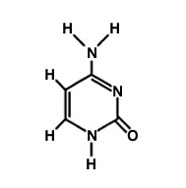
Diagram of the chemical structure of cytosine, one of the four nitrogenous bases in DNA.
|
cytosine - one of the four nitrogenous bases in DNA that make up the letters ATGC. Cytosine is the "C". The others are adenine, guanine, and thymine. Cytosine always pairs with guanine |
cytoskeleton - the network of microtubules, microfilaments, and larger filaments that provides a eukaryotic cell with its structural support, shape, and its capacity to move and arrange its organelles within the cell |
cytosol - the fluid, less structured part of the cytoplasm of a cell, excluding organelles and membranous structures; the portion of the cytoplasm which remains after removal of particulate components� |
cytotoxic - able to cause cell death |
CZCS (Coastal Zone Color Scanner) - a scanning radiometer with six spectral channels centered at 0.443, 0.520, 0.550, 0.670, 0.750 and 11.5 micrometers and selected to allow measurement of ocean color and temperature, suspended sediment and chlorophyll concentrations, and ocean pollutants |
|
|
|
|

